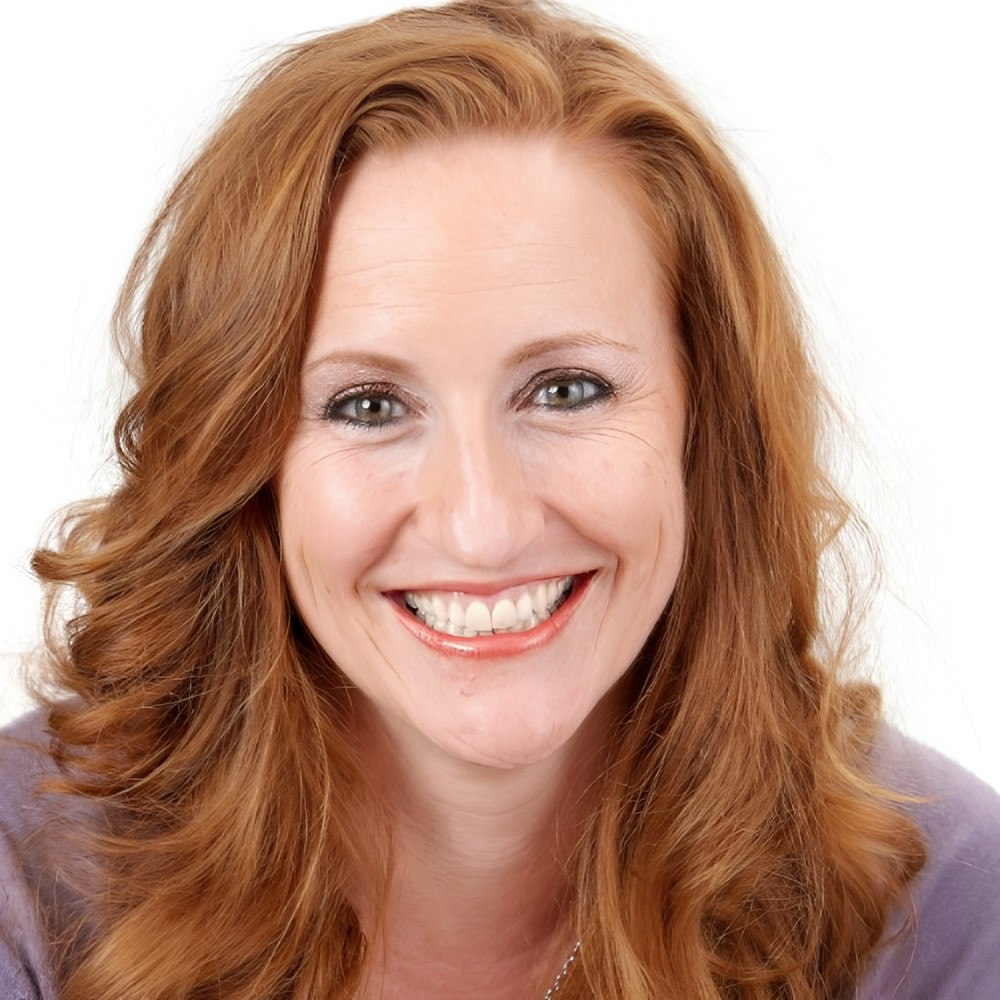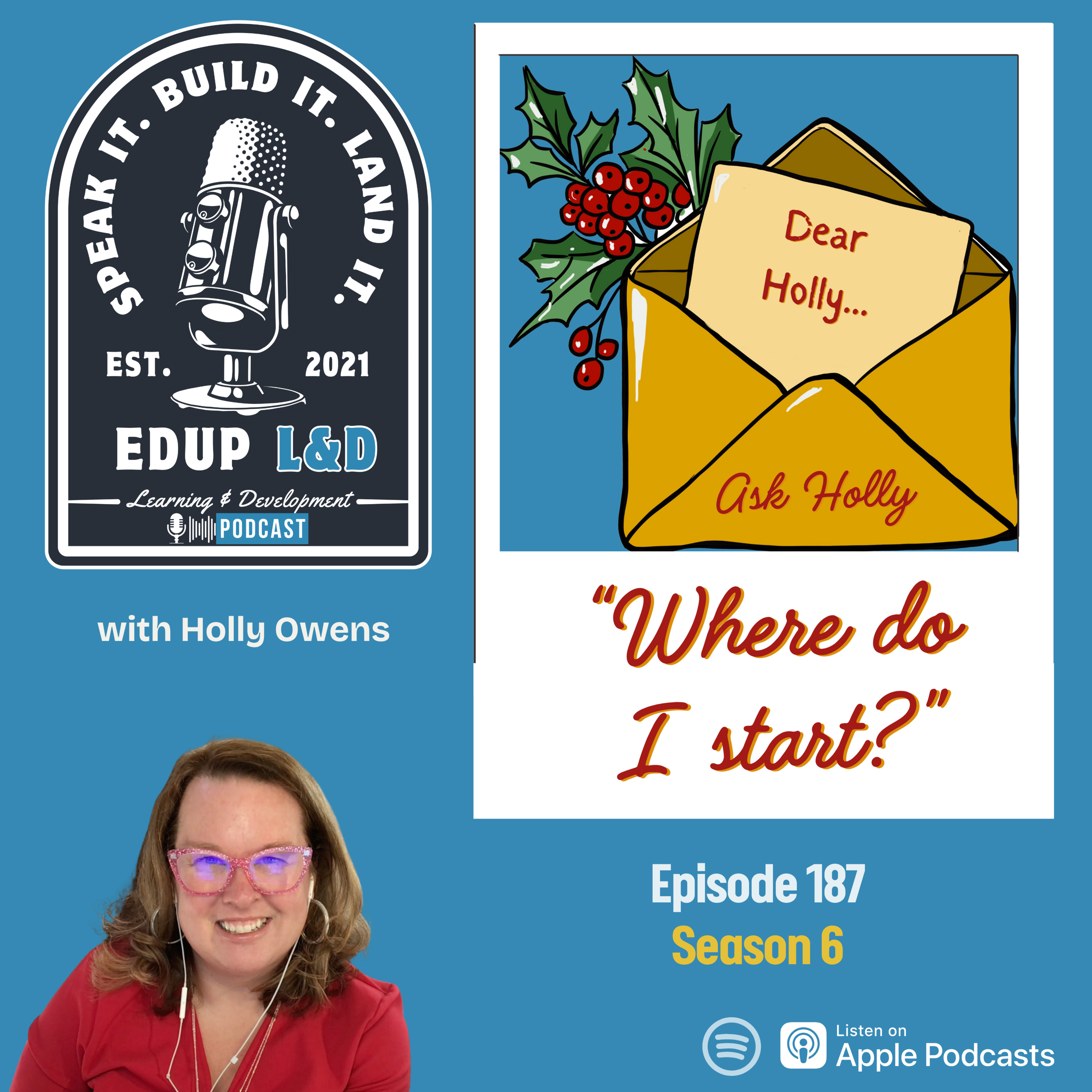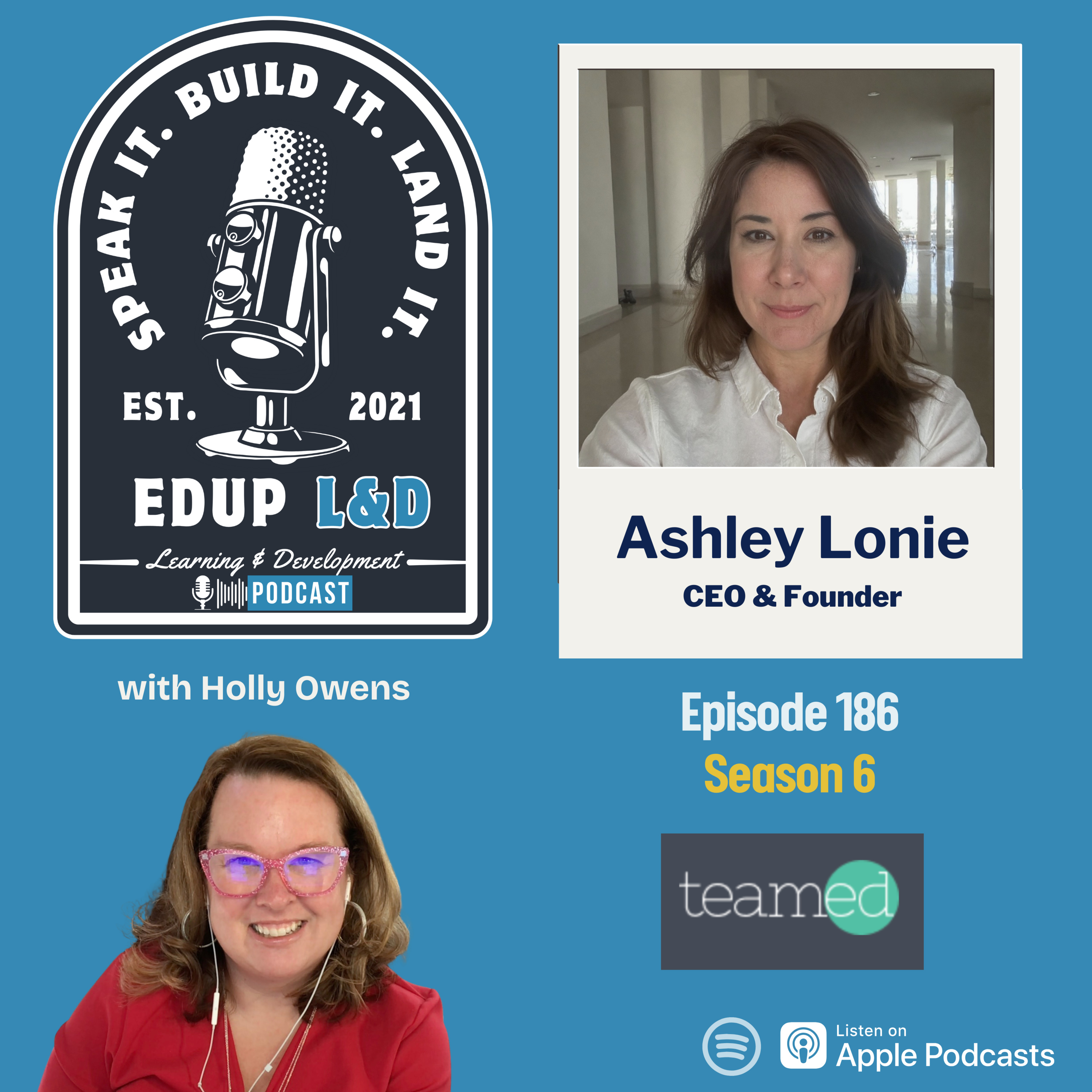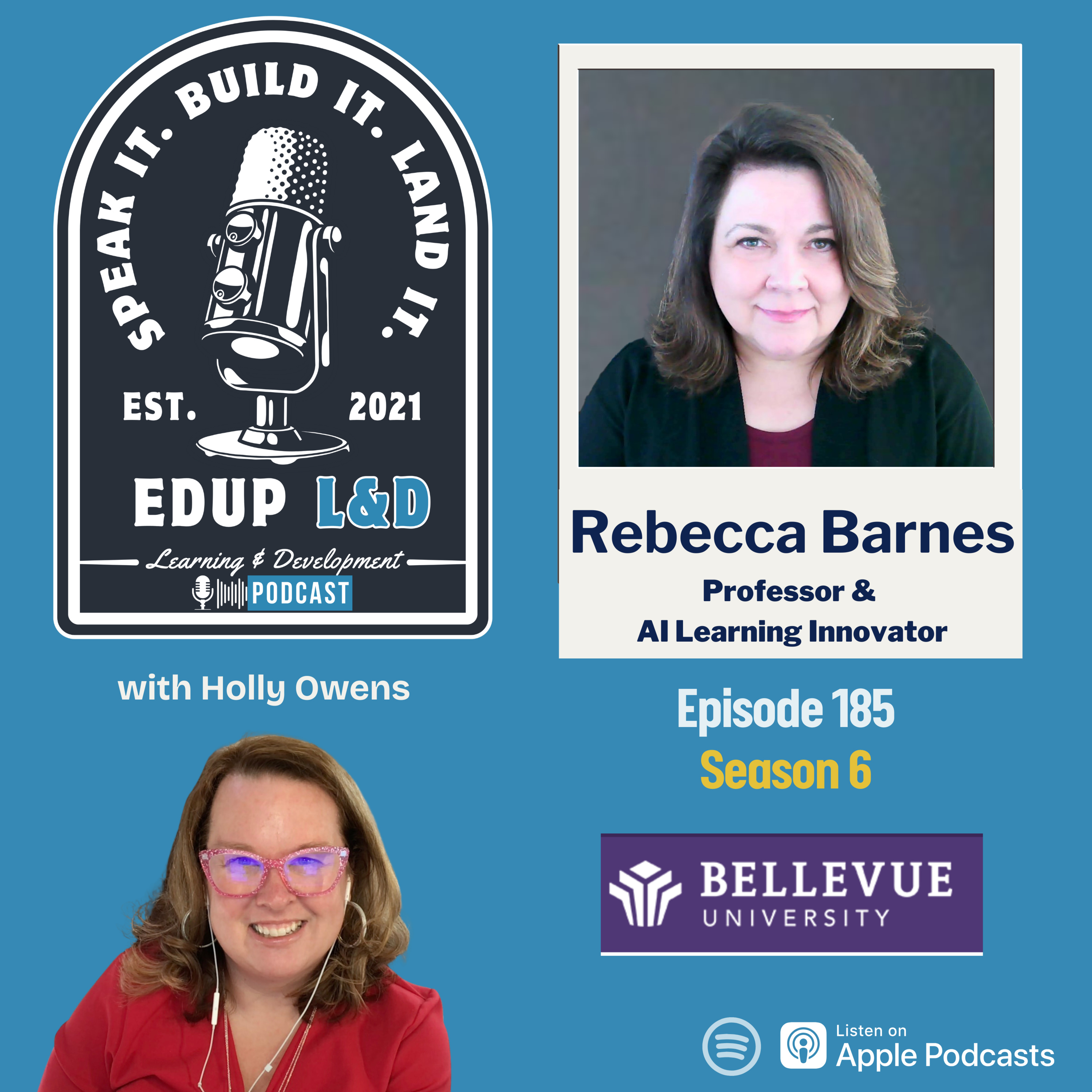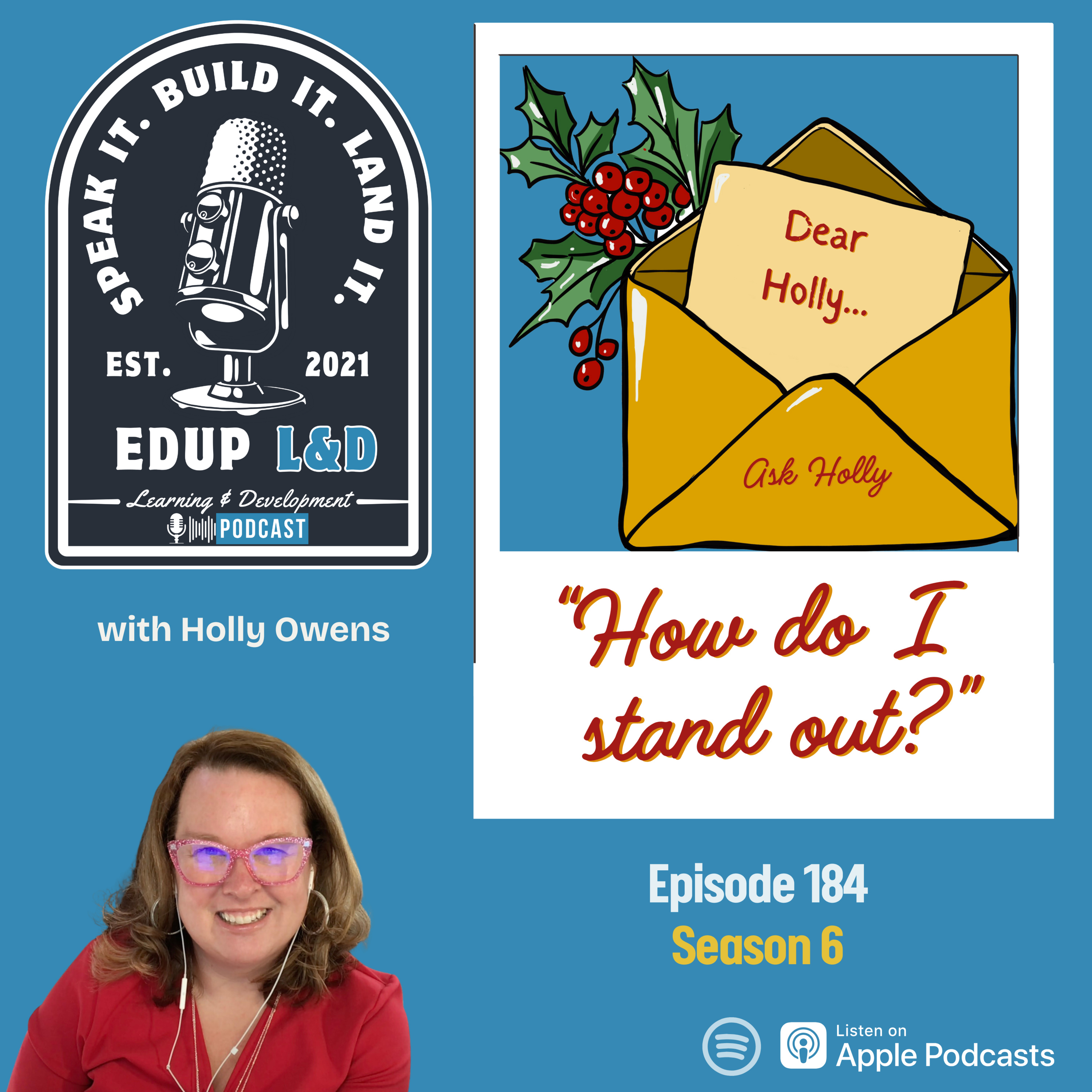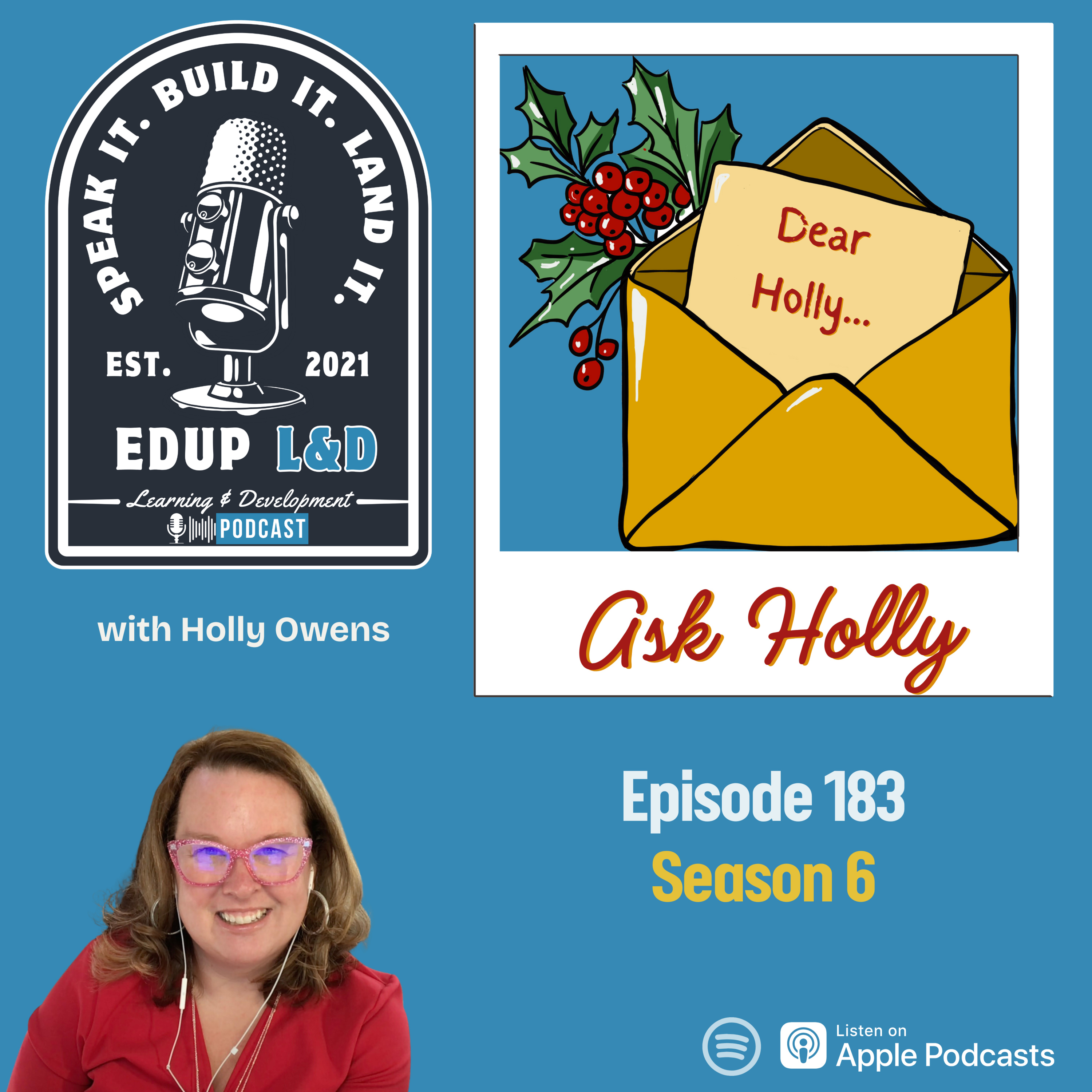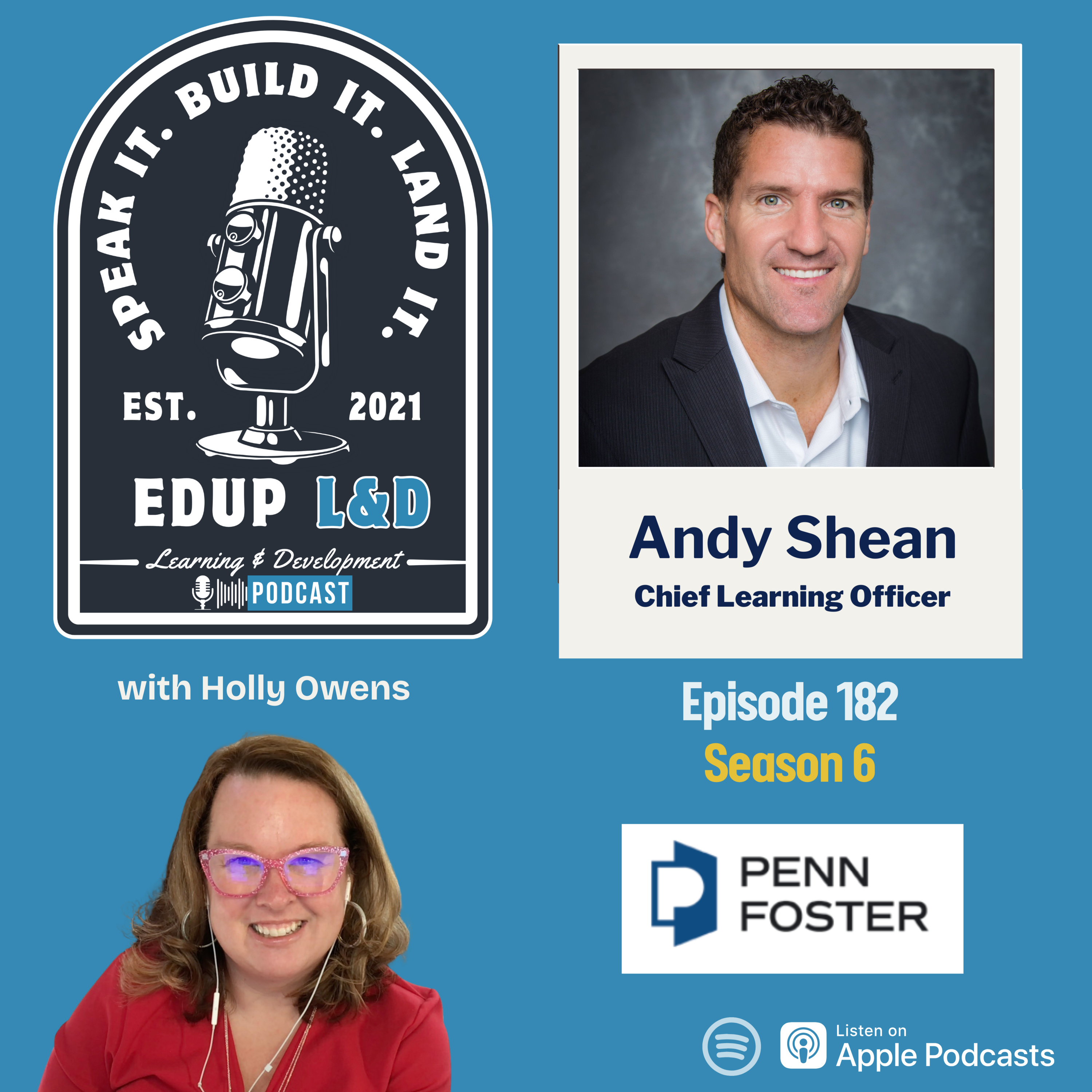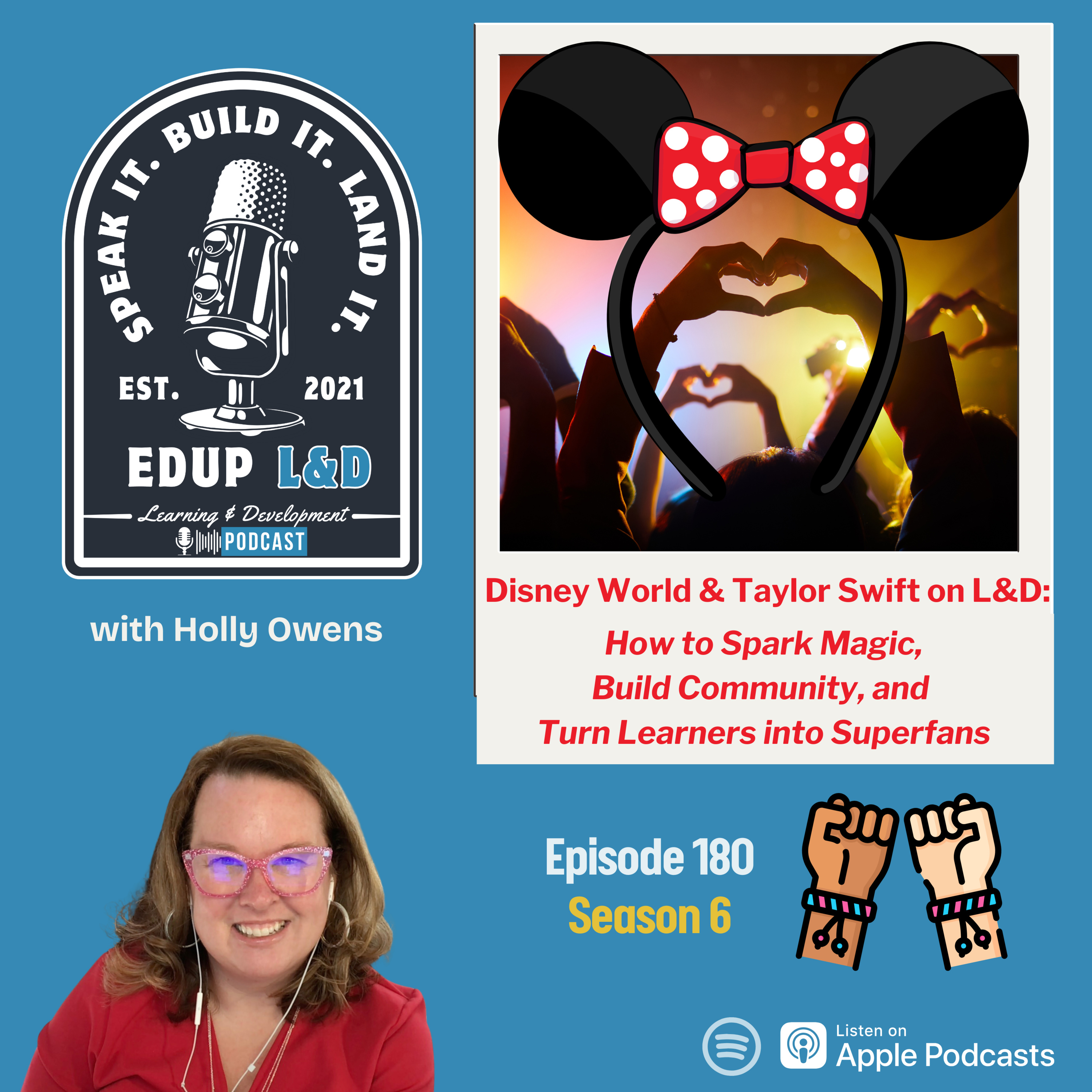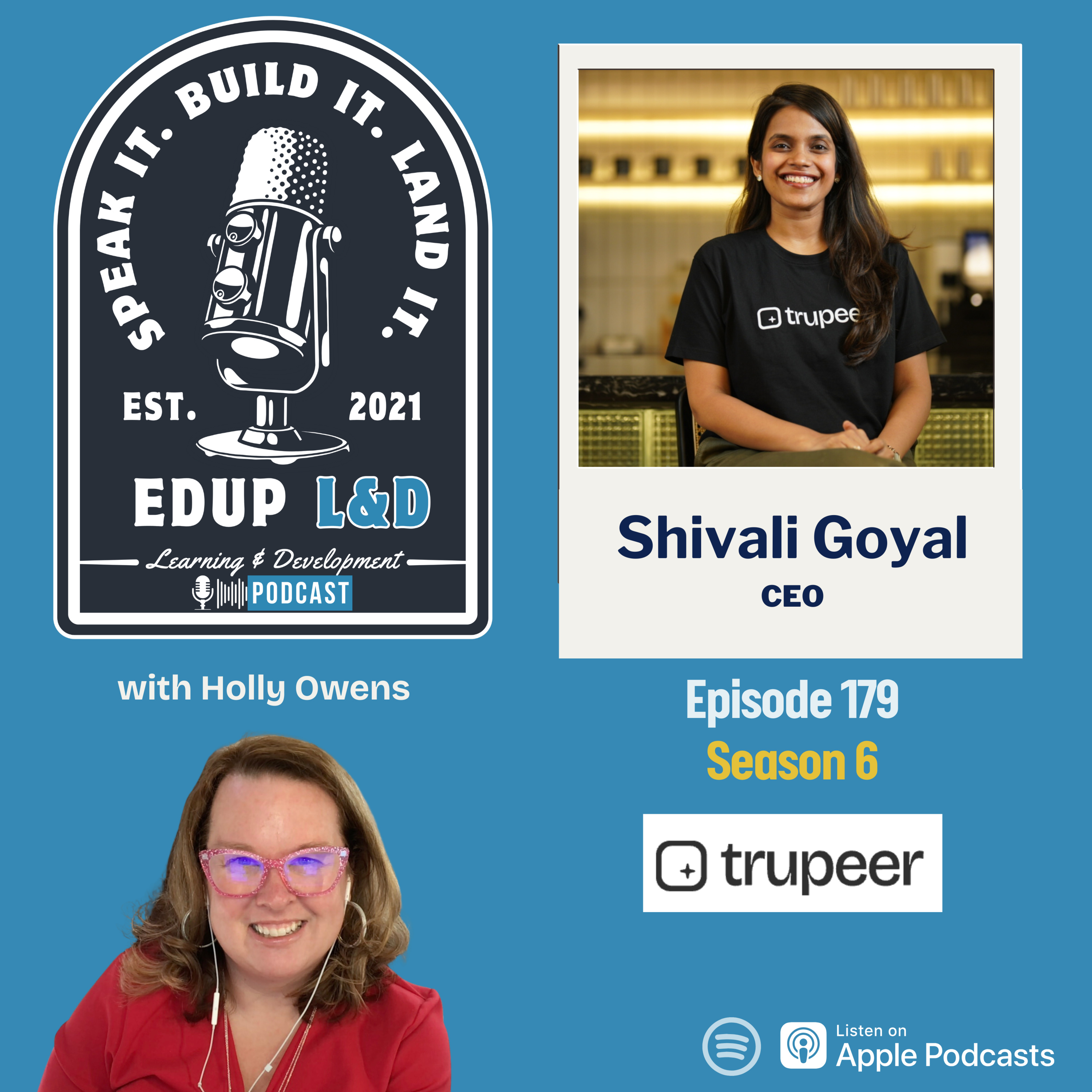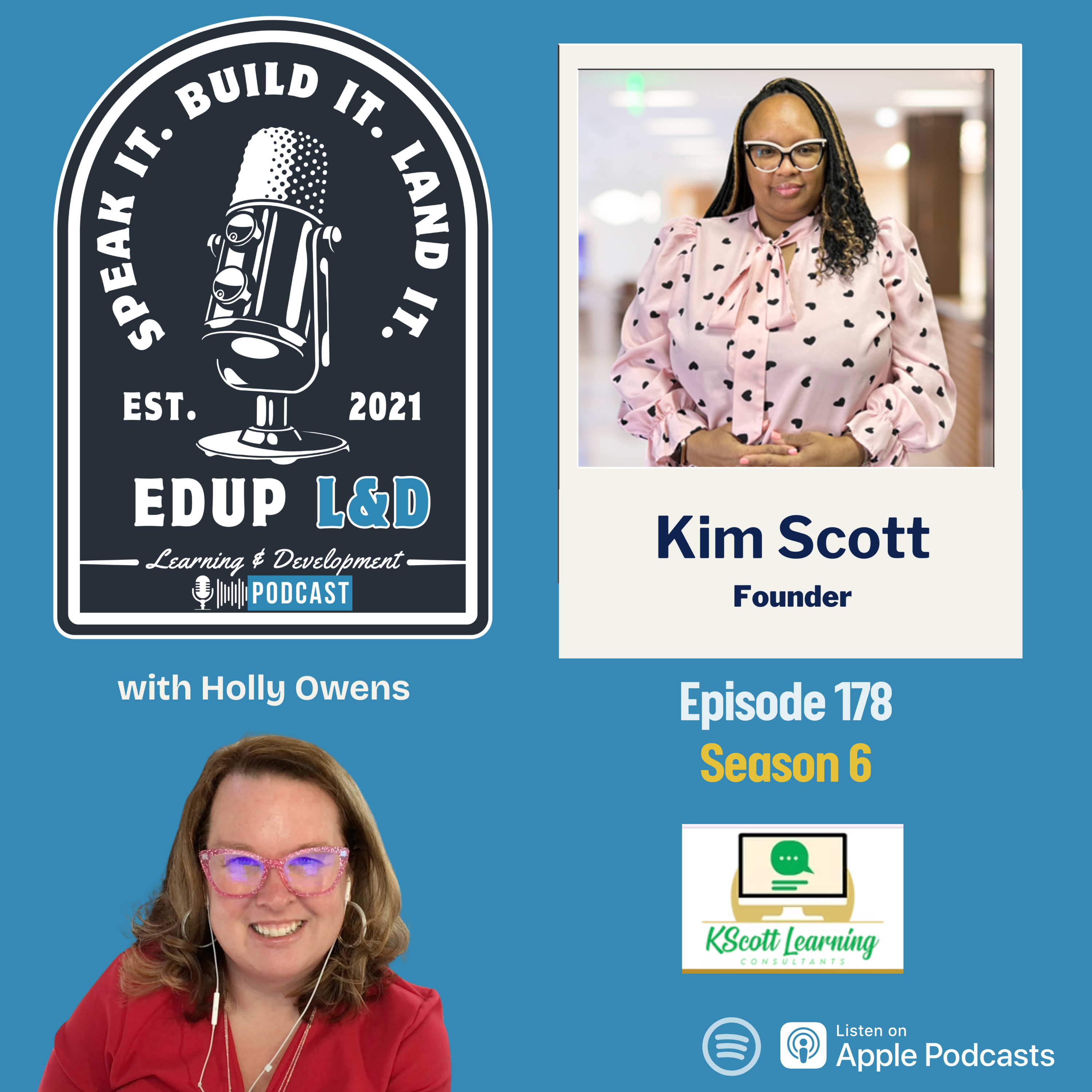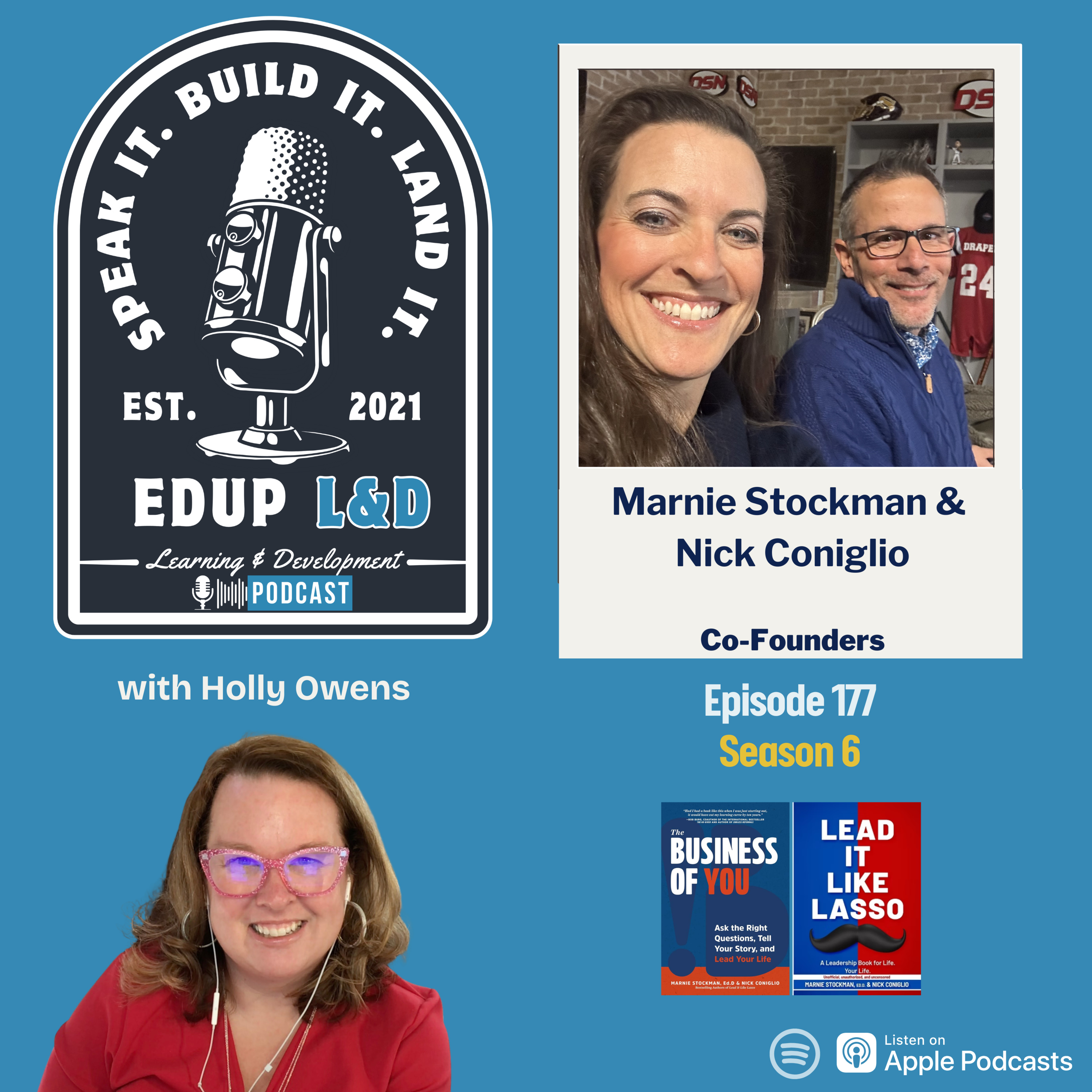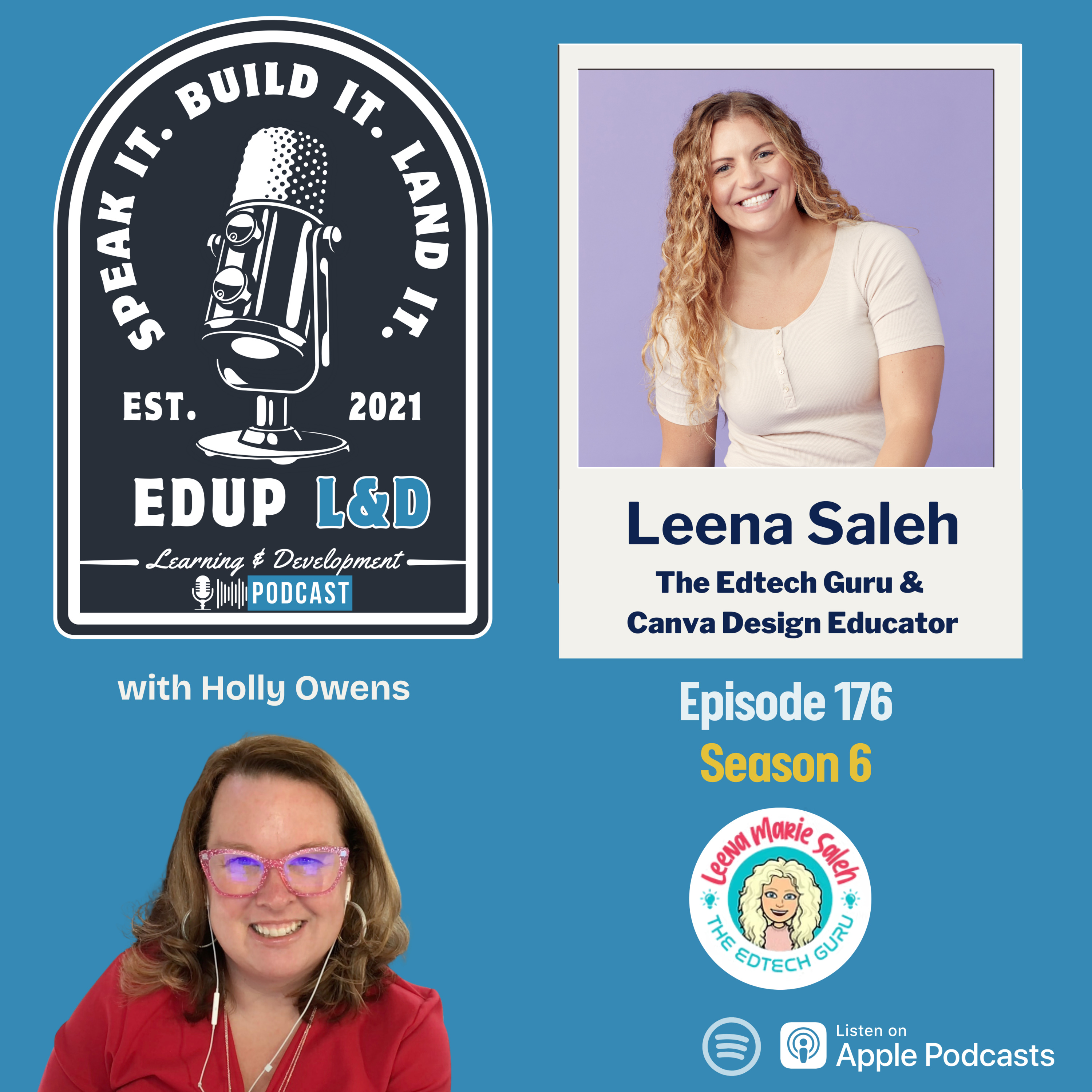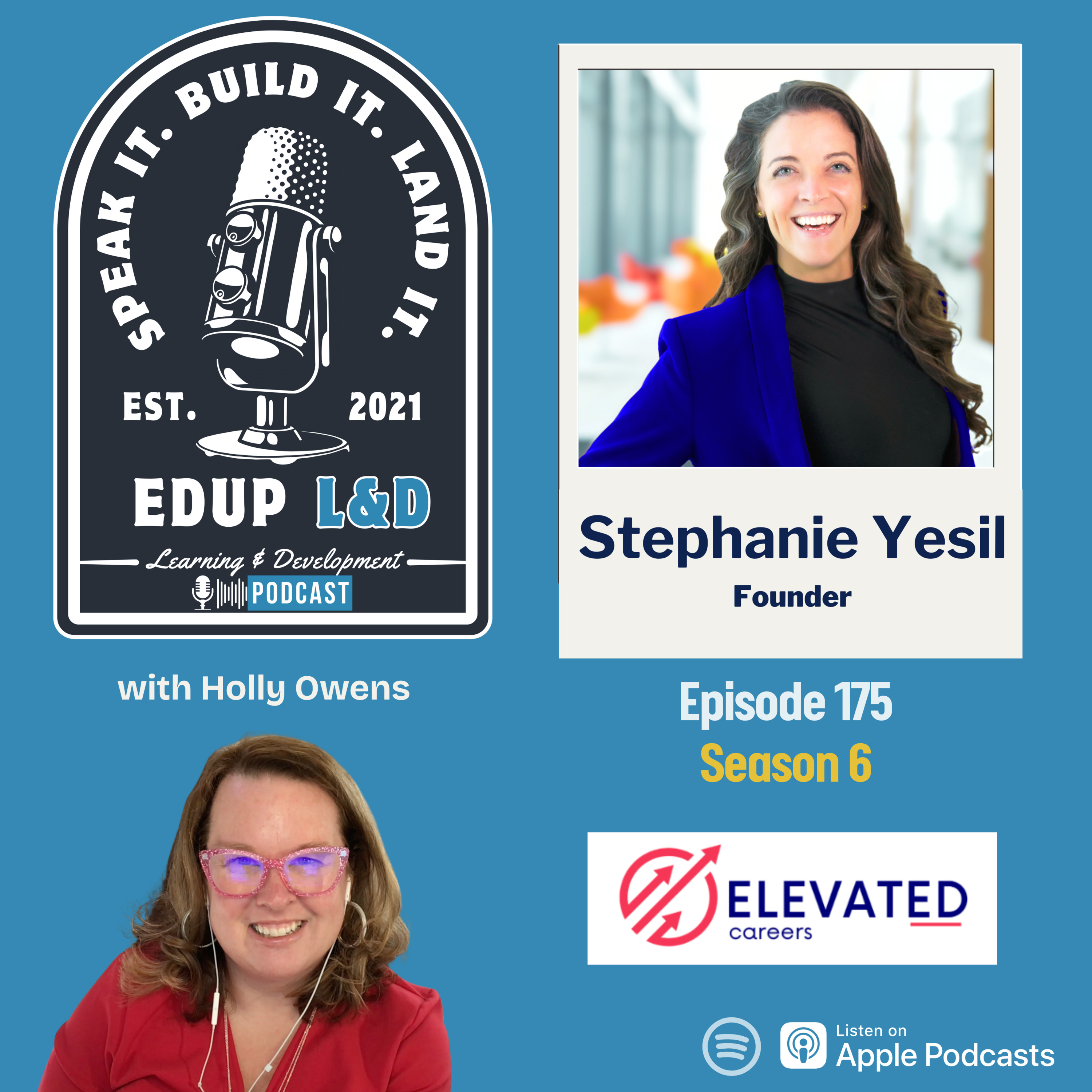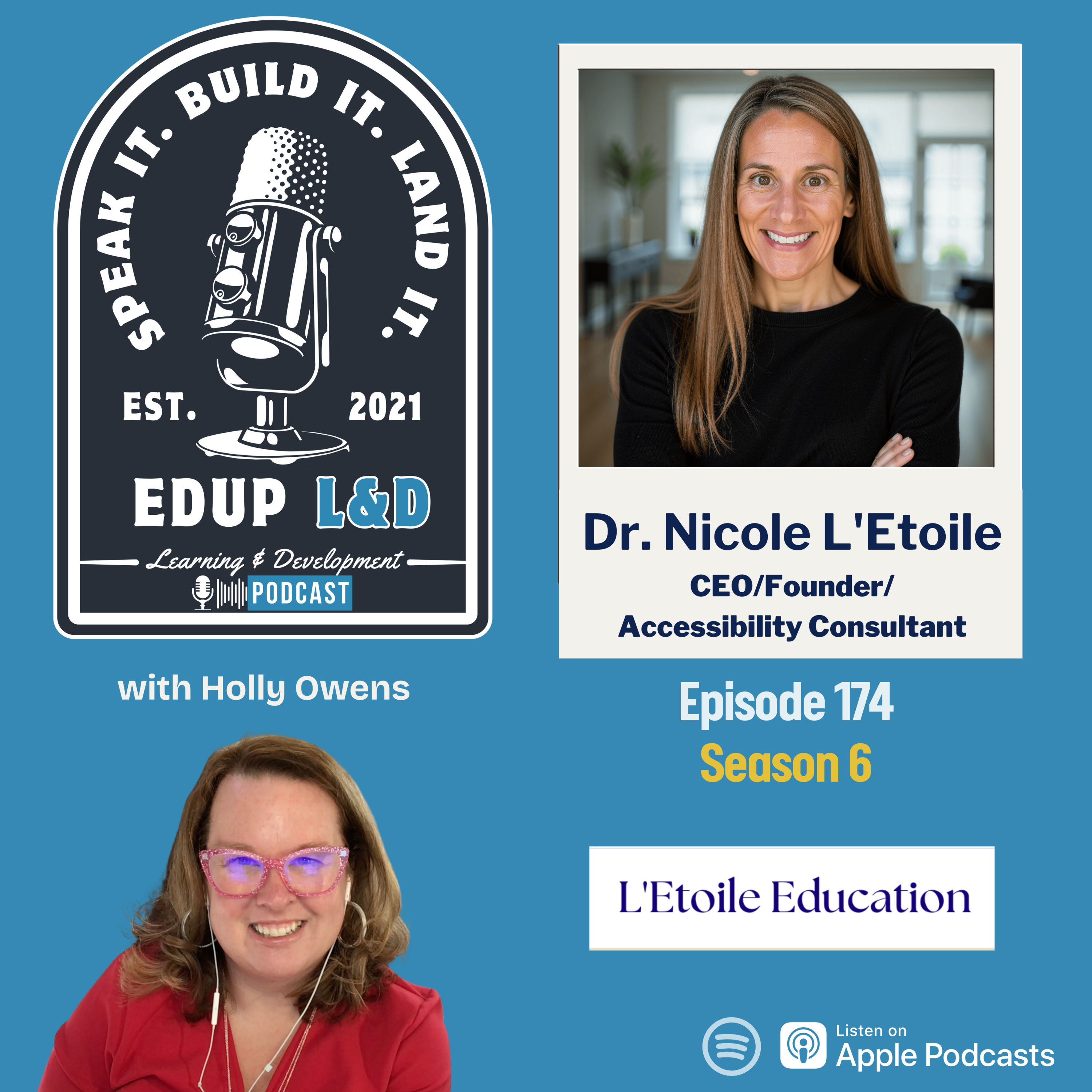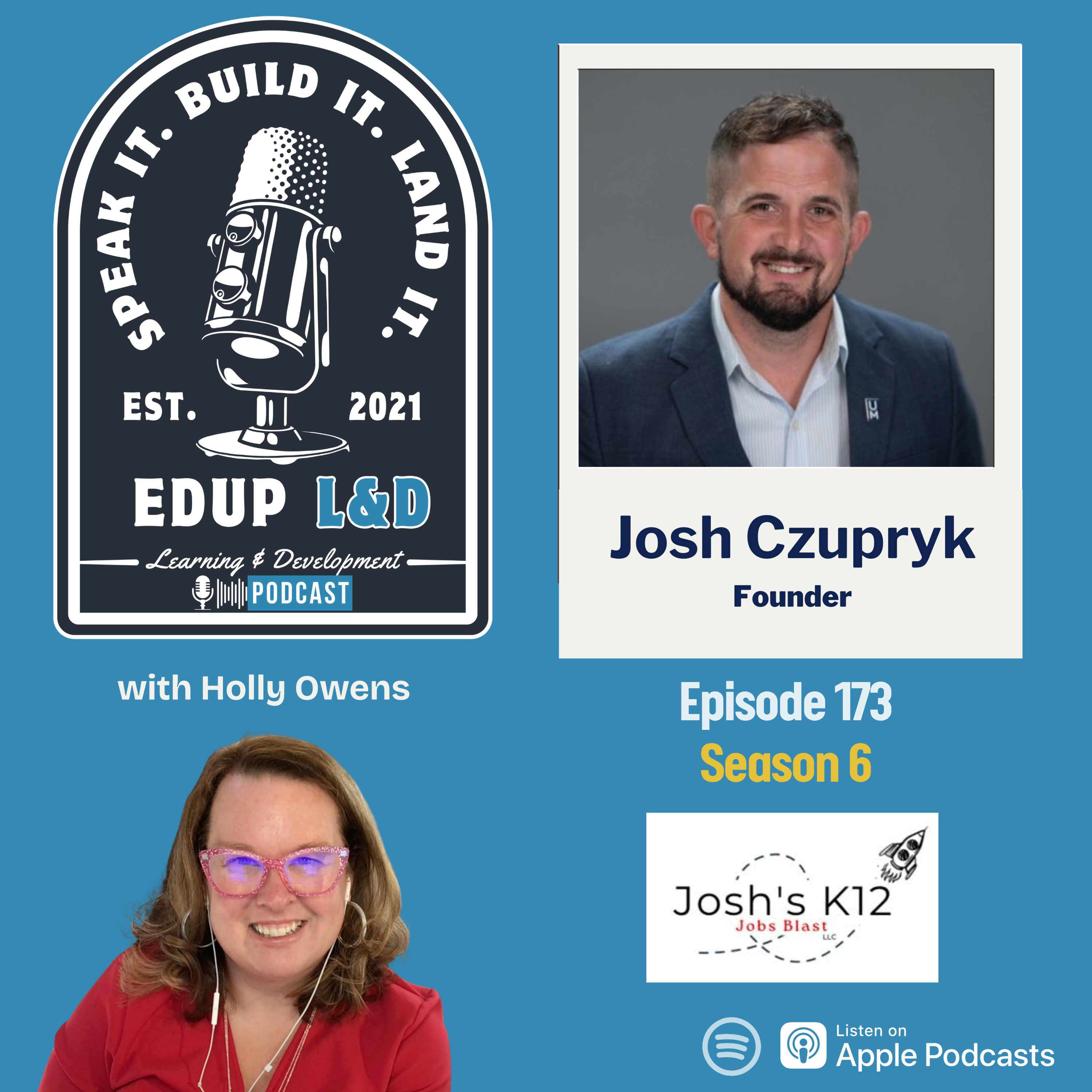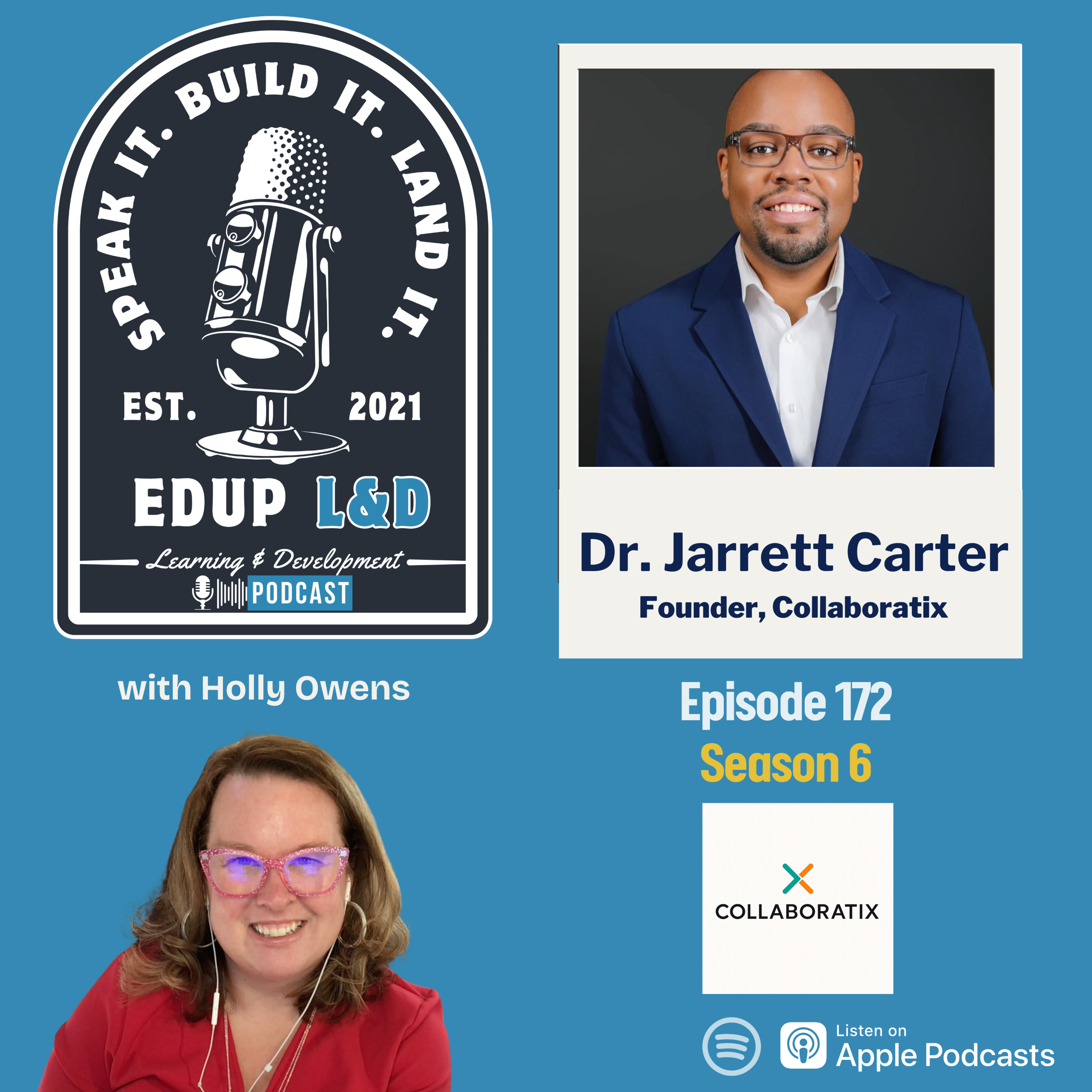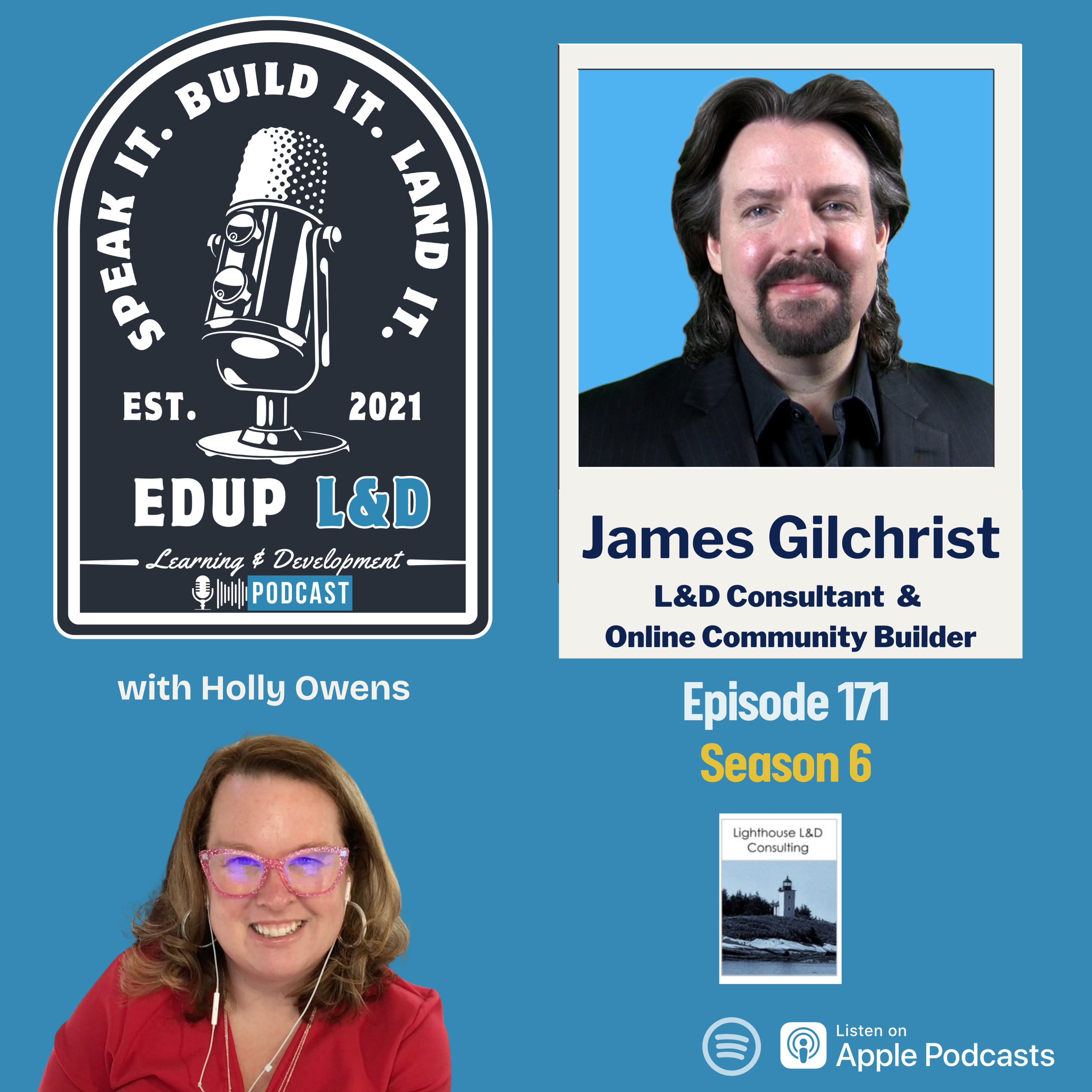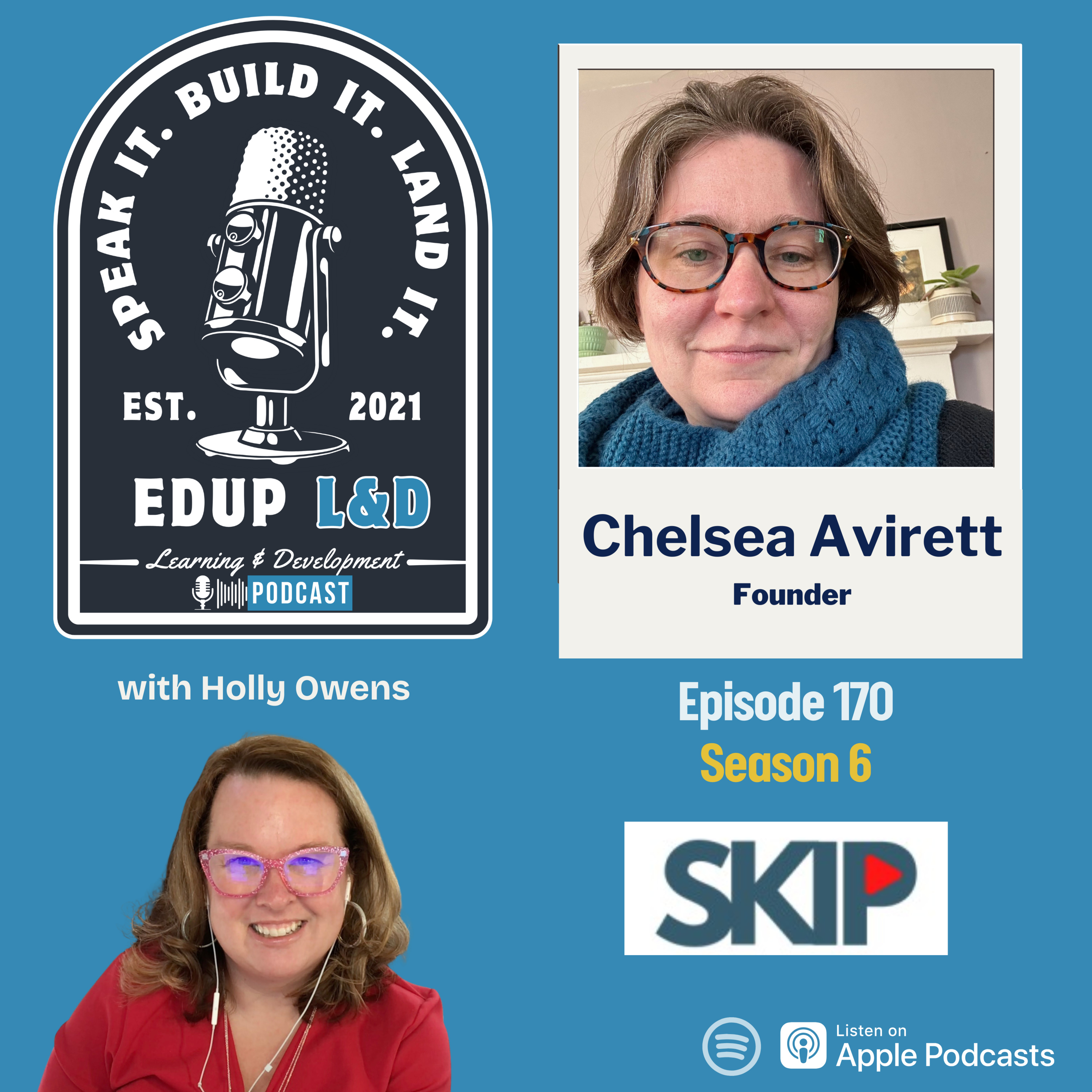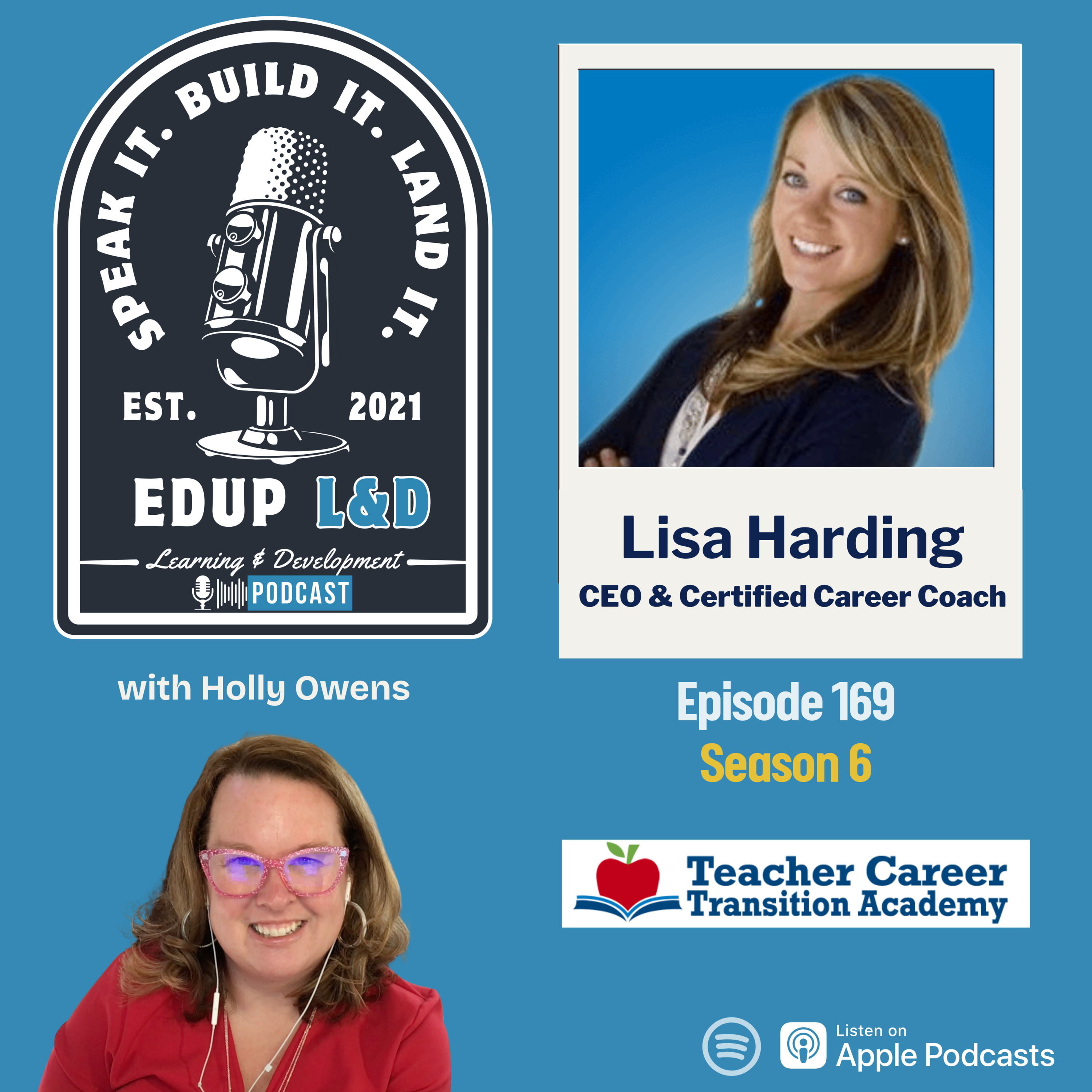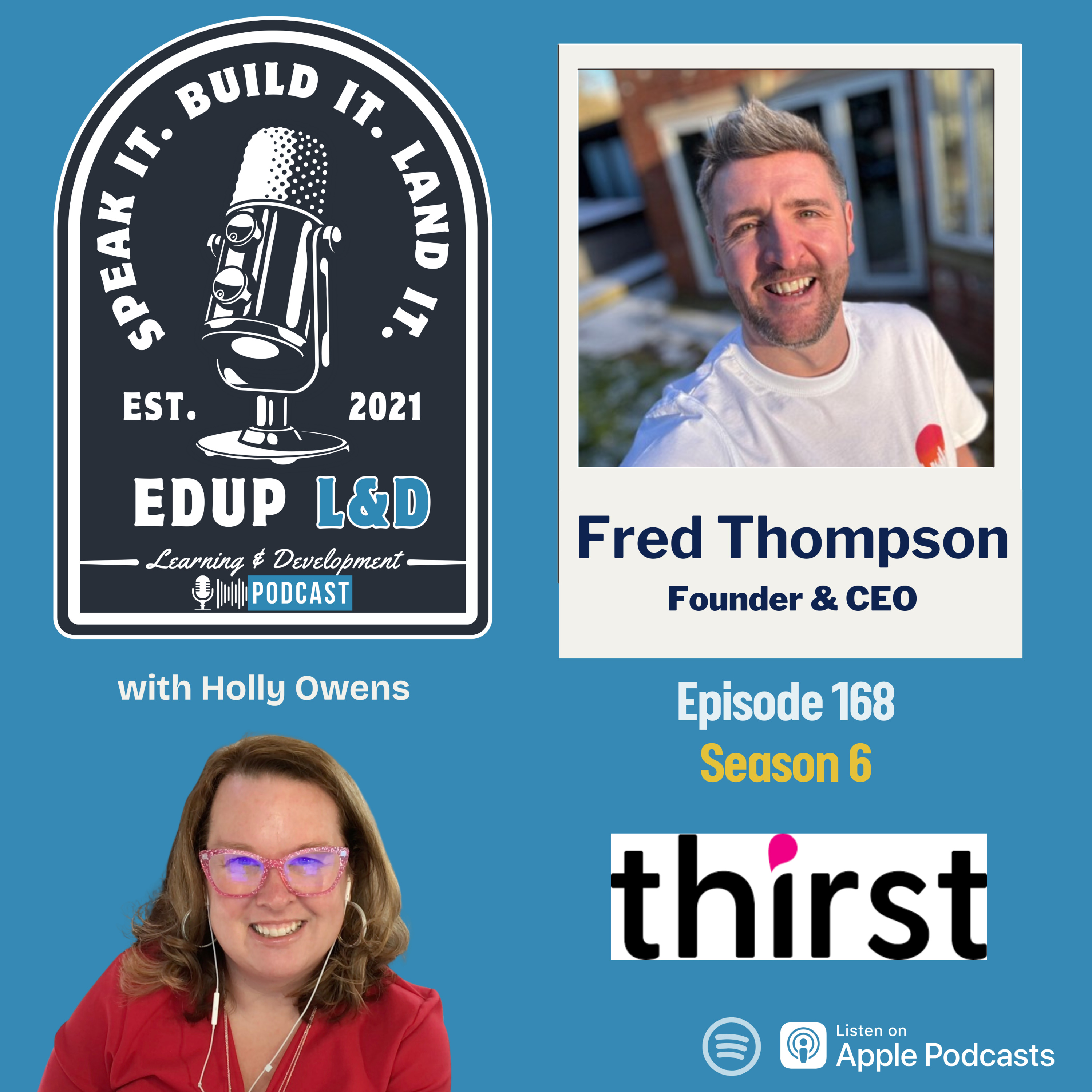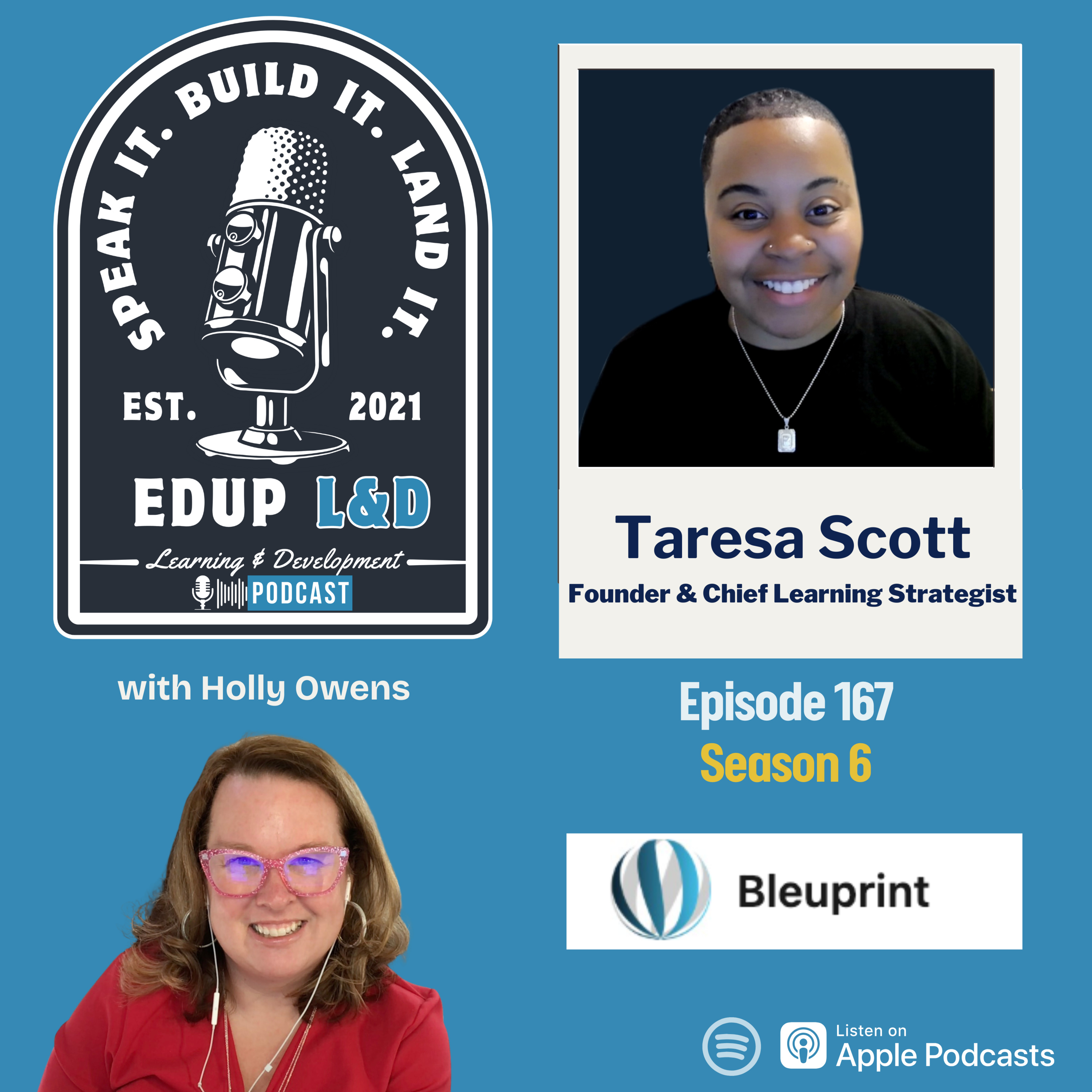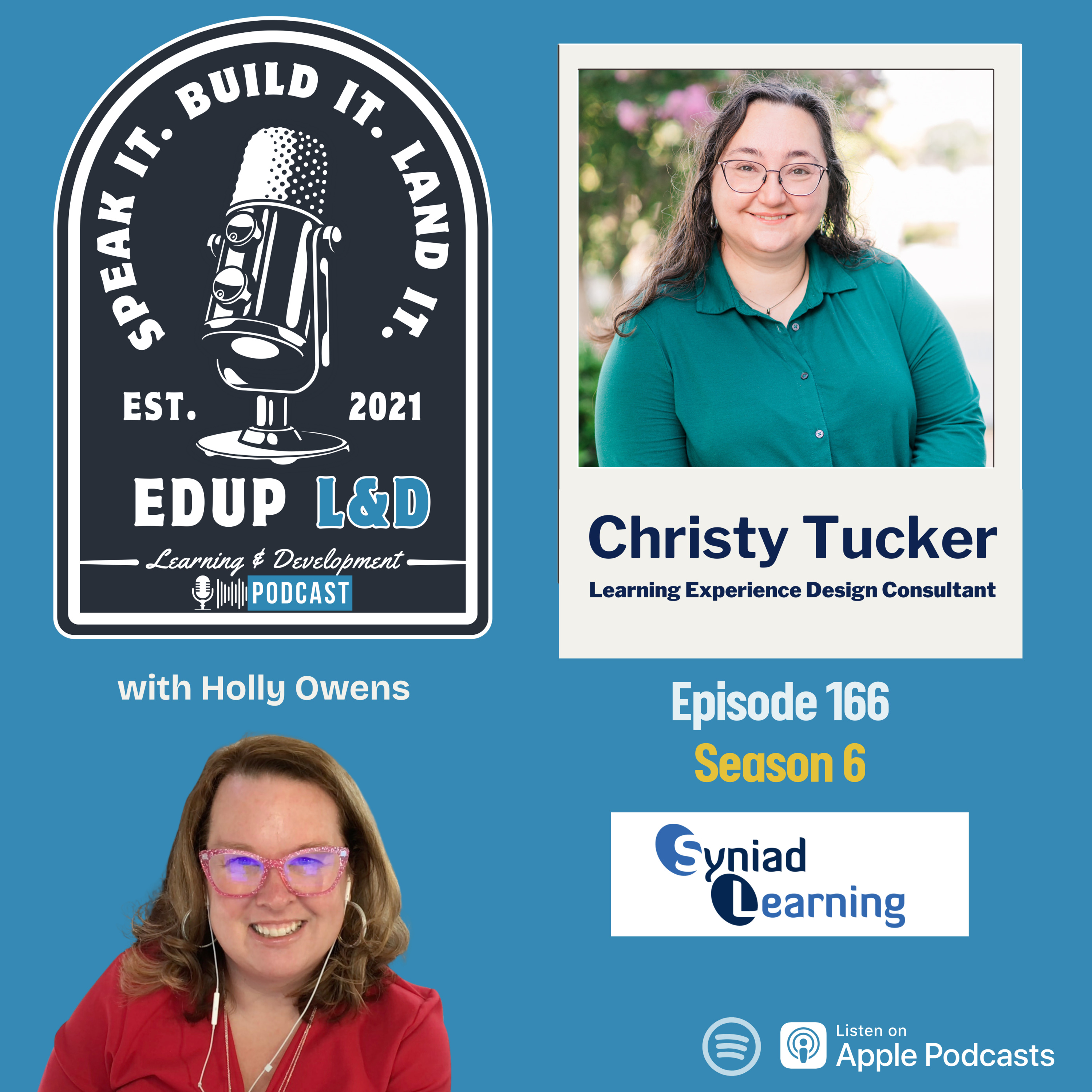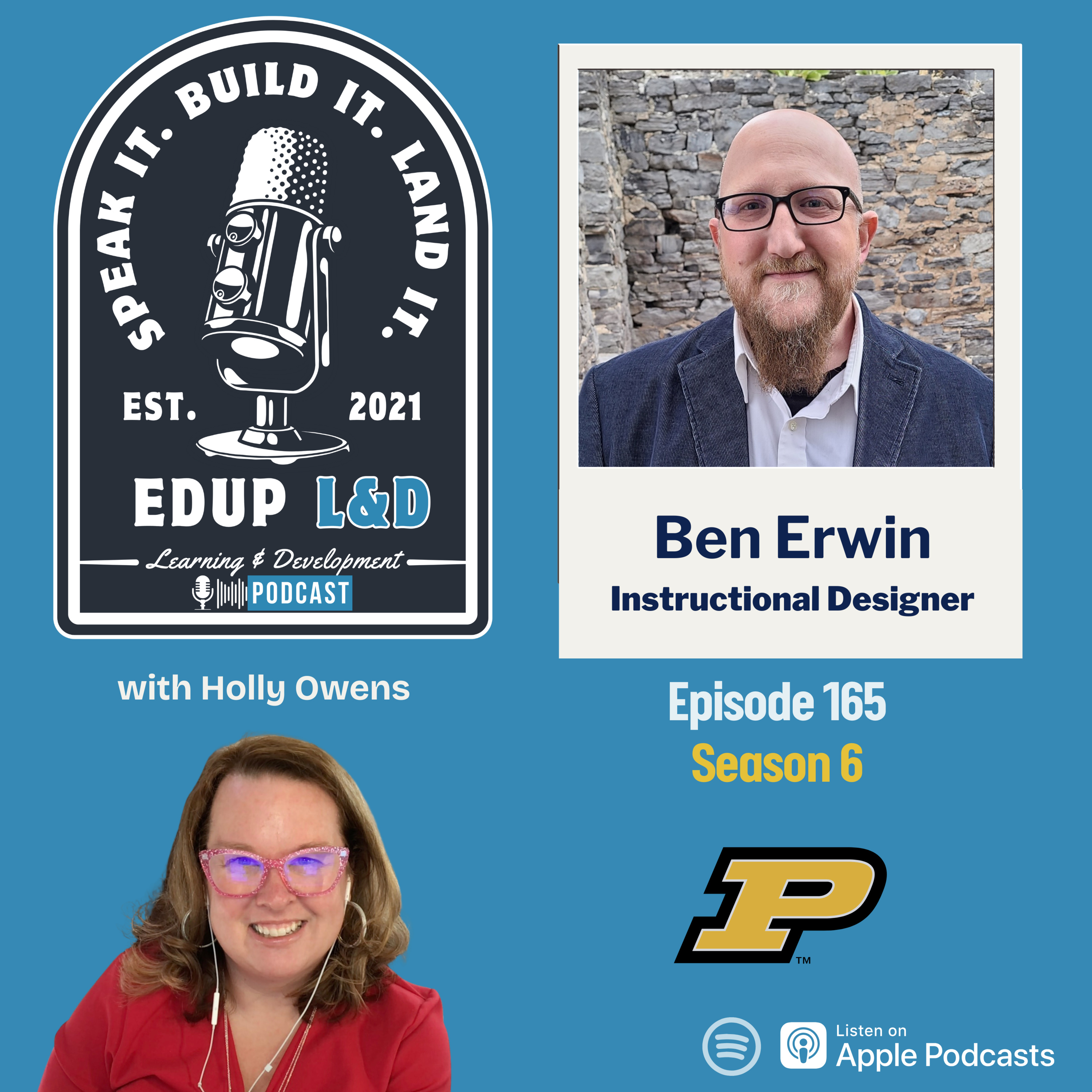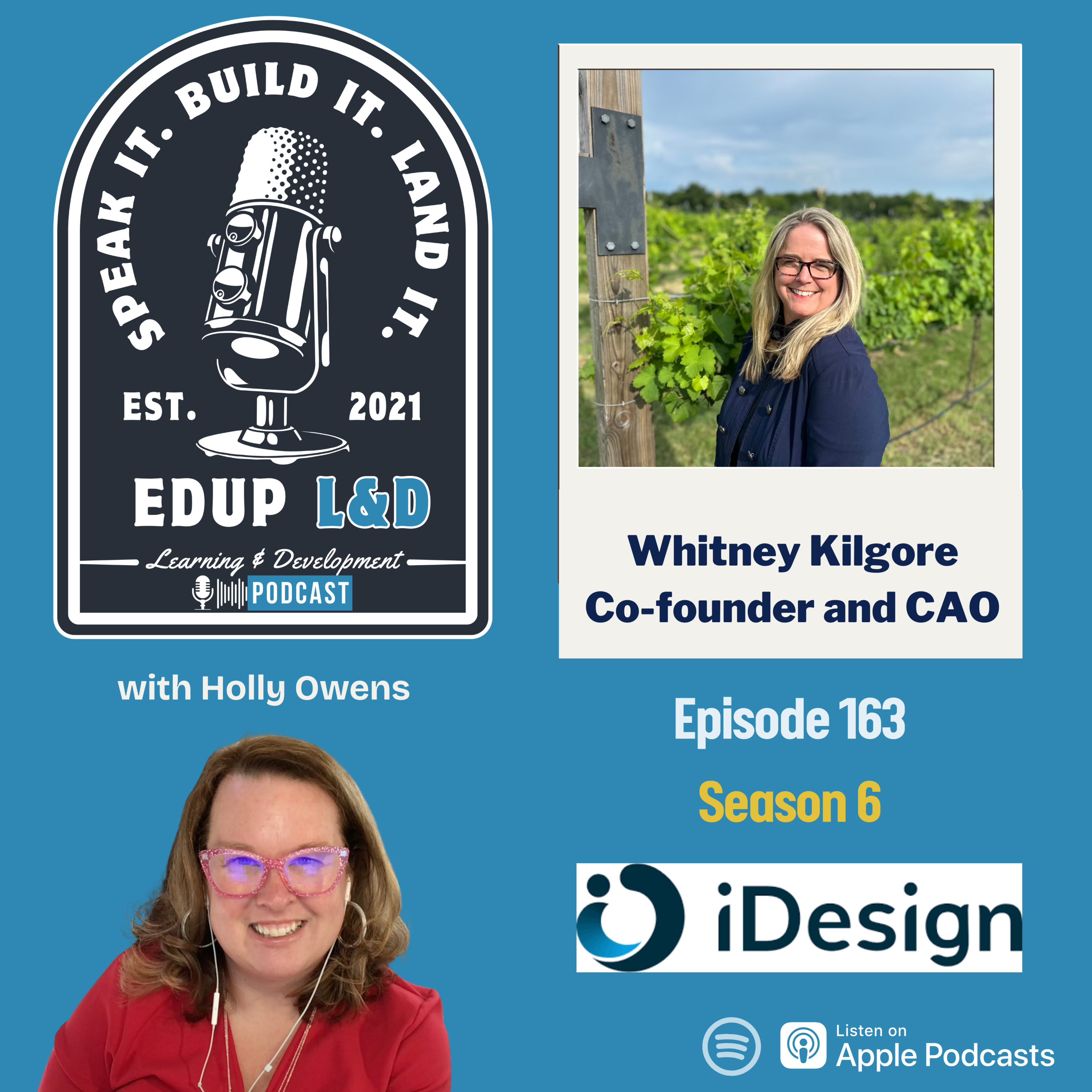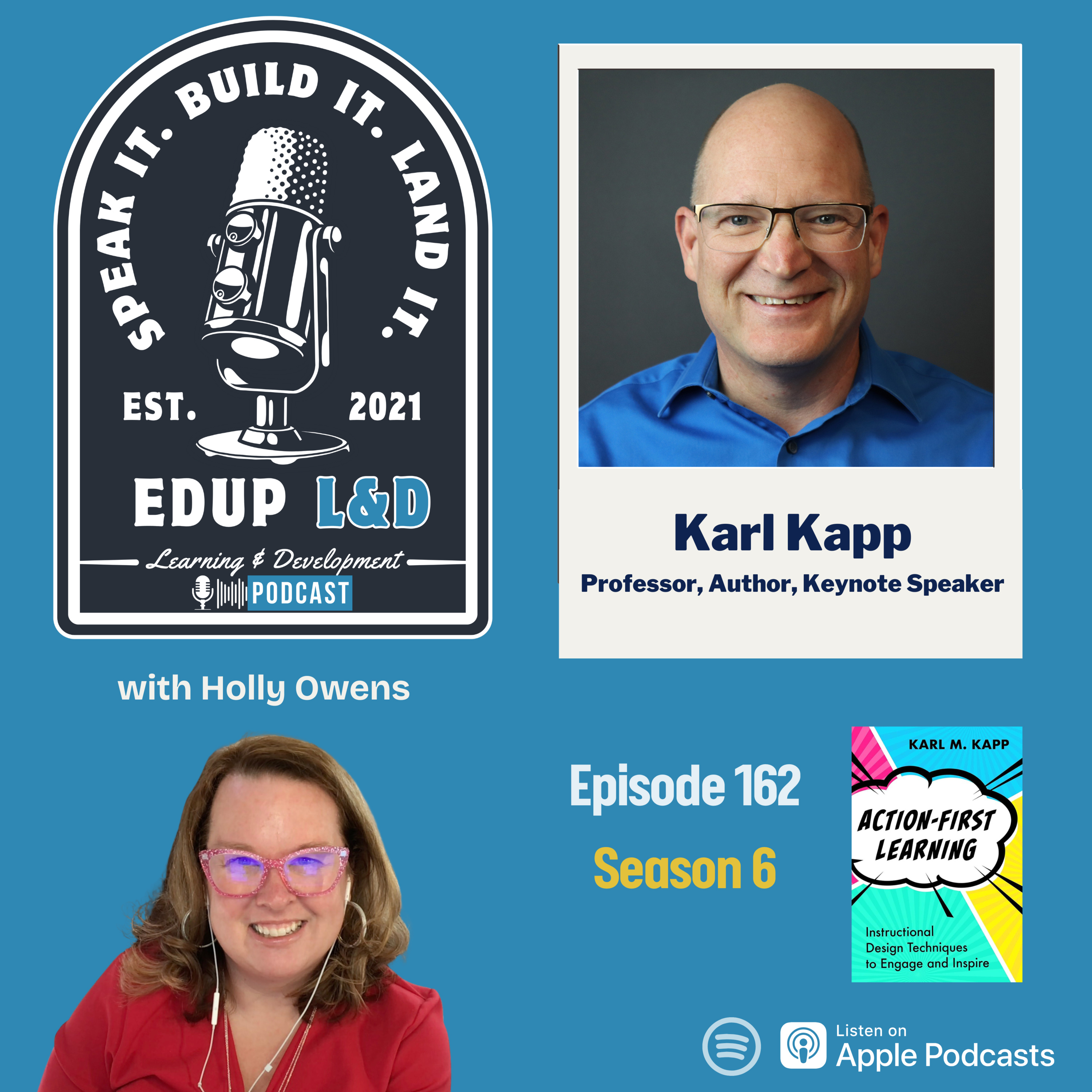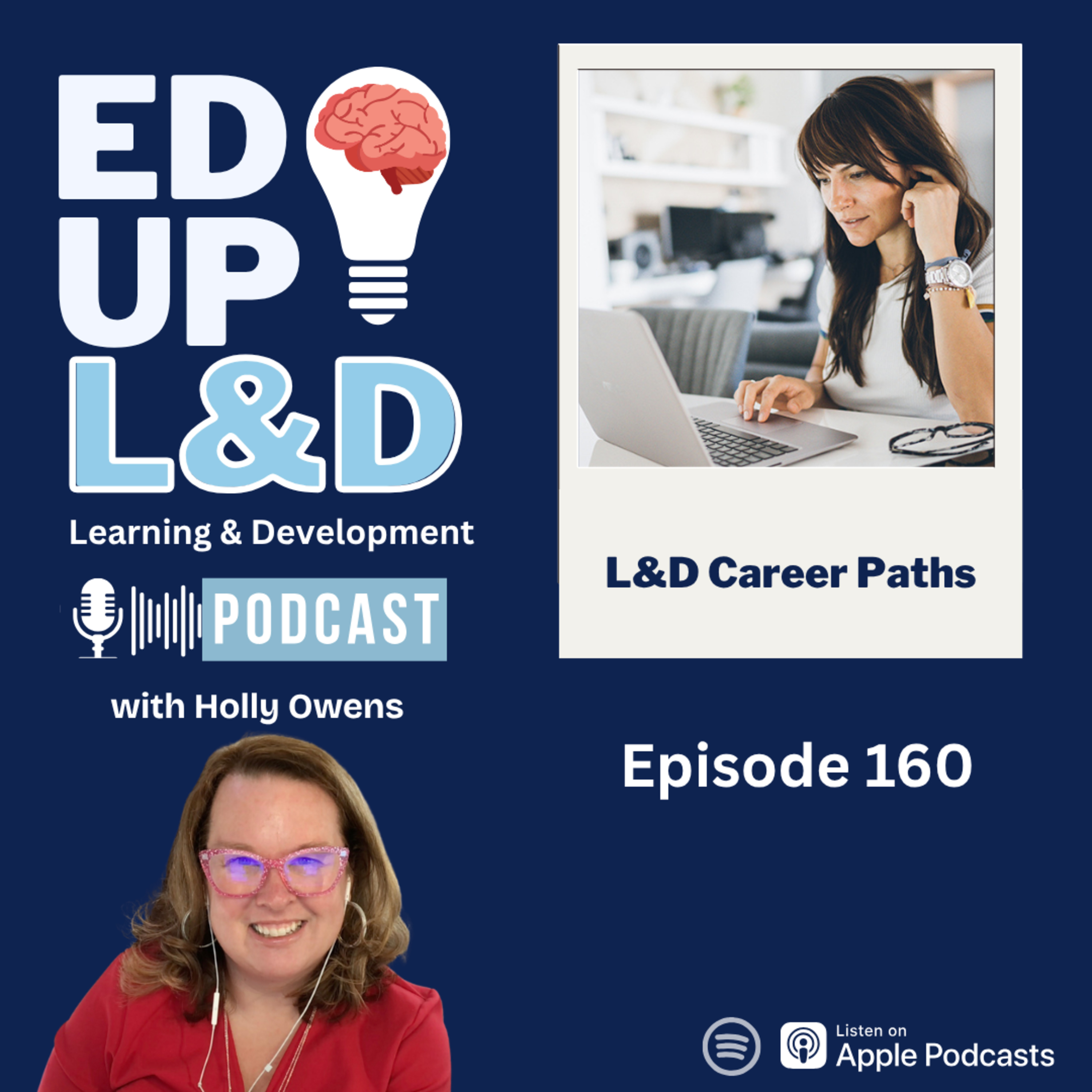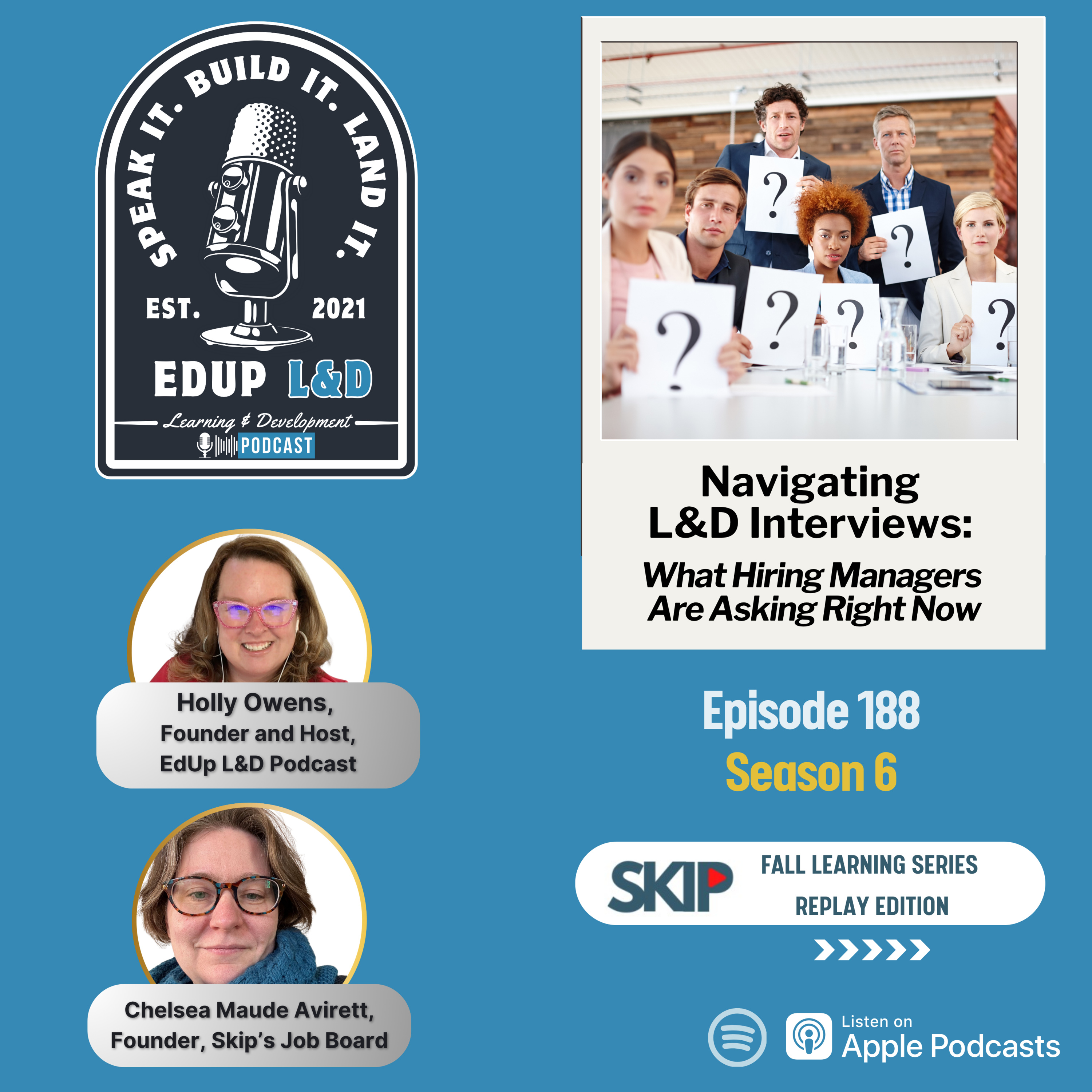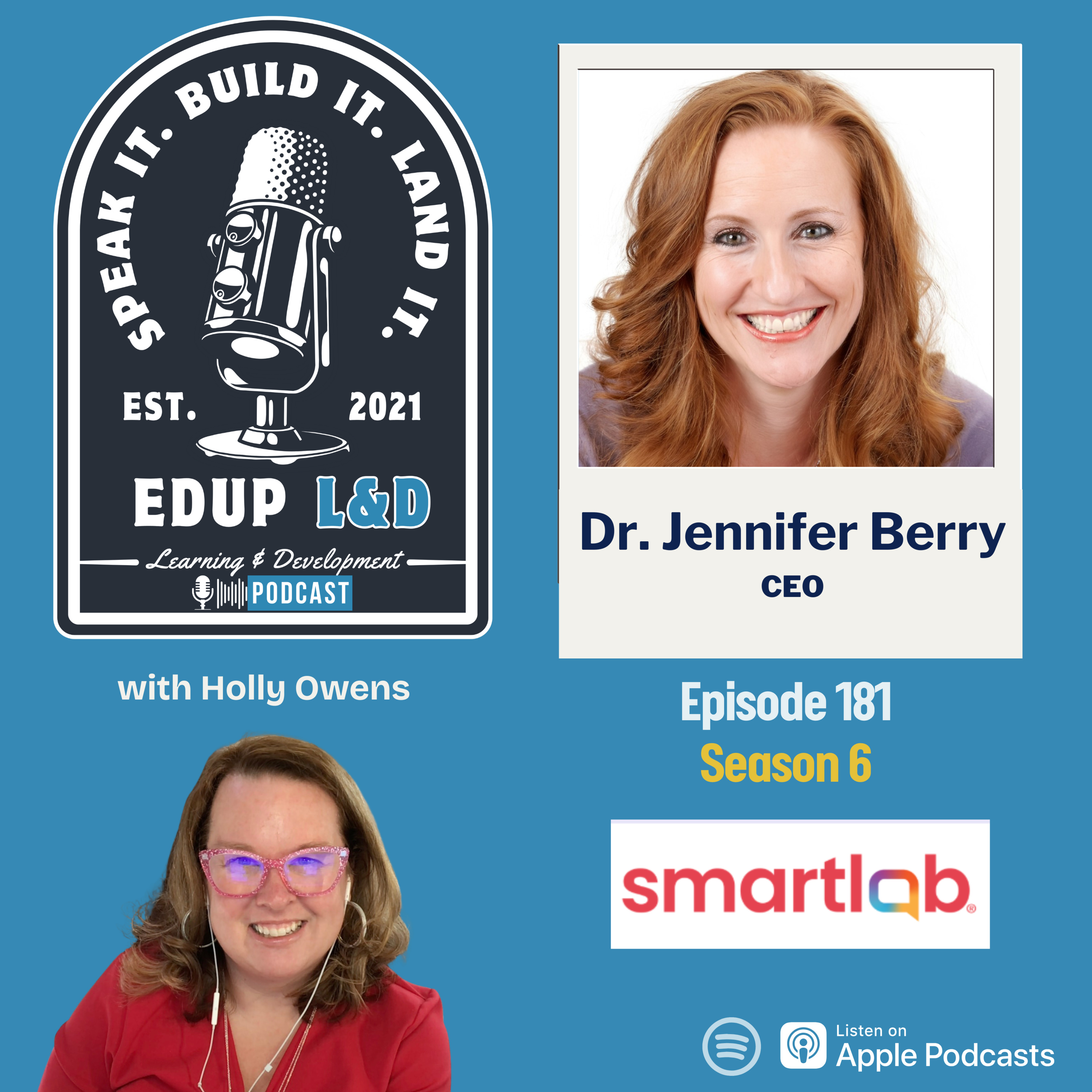
In this episode of EdUp L&D, host Holly Owens interviews Dr. Jennifer Berry, CEO of SmartLab, who shares her inspiring journey from professional dance to leading a STEM education organization. Dr. Berry discusses the importance of STEM identity in learners, SmartLab's mission to create engaging learning environments, and how they prepare students for a future influenced by AI. She also offers valuable advice for aspiring leaders and CEOs, emphasizing curiosity, learning without expectations, and staying rooted in one's values.
In this episode of EdUp L&D, host Holly Owens interviews Dr. Jennifer Berry, CEO of SmartLab, who shares her inspiring journey from professional dance to leading a STEM education organization. Dr. Berry discusses the importance of STEM identity in learners, SmartLab's mission to create engaging learning environments, and how they prepare students for a future influenced by AI. She also offers valuable advice for aspiring leaders and CEOs, emphasizing curiosity, learning without expectations, and staying rooted in one's values.
Resources mentioned in this episode:
Guest Contact Information:
___________________________________
Episode Sponsor: iSpring Solutions
🎙️ Huge thanks to our friends at iSpring Solutions for sponsoring this episode of the EdUp L&D podcast! 🙌
If you haven’t already, be sure to check out the iSpring Learning Exchange Community — a vibrant space for creators, educators, and L&D pros to connect and grow.
Grateful for the support and excited to see what our community creates 💡
Thanks for tuning in! 🎧
Holly Owens (00:00.812)
Hello everyone and welcome to another fabulous episode of EdUp L &D. My name is Holly Owens and I'm your host and I'm really excited today because I finally, finally, finally, we got all the technical bad things out of the way, get to talk to Dr. Jennifer Berry She's the CEO of SmartLab. So Dr. Jennifer, welcome to the show.
Dr. Jennifer Berry (00:26.517)
Thank you for having me, Holly. I really appreciate your time and your listener's time. And I know we had a little bit of technical challenges, but we wouldn't be a STEM organization if we didn't figure out those technical challenges. So we got it working.
Holly Owens (00:37.309)
Exactly. We are steadfast. We don't let challenges, you know, block us. We figure it out and we move forward. So I'm excited to have you and to learn more about you. So our audience is obviously made up of like L and D professional CEOs, founders, transitioning teachers, people who are still teachers in the classroom. So I would love for you to share your journey with the listeners. How did you become a CEO of a smart lab?
Dr. Jennifer Berry (00:44.649)
Yeah. Thank you.
Dr. Jennifer Berry (01:05.211)
question. So I started early in my career. Well first of all I was a professional dancer. early in my career I did storytelling through physical movement. So I am a physical movement individual. I really believe in telling a story through your body. I also been in the performing arts theater world for some years. Everything from directing and choreographing and all of that. You know after your body ages and you can't professionally dance anymore you have to go into choreography.
Holly Owens (01:10.85)
Wha- Wow.
Holly Owens (01:34.474)
Yeah, yeah.
Dr. Jennifer Berry (01:35.241)
And I'm really passionate about, young storytellers that want to tell stories through their bodies. I'm really passionate about that. So that was my early career. And then through my college experience, I needed to get in-state tuition at University of Arizona. And I decided to walk down the mall with a baseball hat and a sweatshirt, ask for applications in the mall, and happened to meet a bunch of
men that were standing in front of the GAP store and they said to me, hey, not only are we gonna give you an application, do you know that we're starting a management intern program for individuals that are in their junior year of college and this will be the first time that we do this intern program and at the end of the program, we'll automatically give you a job and you can move to anywhere that you want, preferably San Francisco where GAP was headquartered. And I was like,
Holly Owens (02:13.324)
cool.
Dr. Jennifer Berry (02:29.333)
Wait, me and this baseball hat and a sweatshirt, I'm just walking through the mall, but that sounds great. So here I joined Gap Inc. and joined their management intern program. It was the first intern program for the company. And this was way back in the 90s. so early 90s, yeah, the 90s are the best, right? And this is when Gap was at their peak and really at the forefront of advertising.
Holly Owens (02:31.566)
you
Holly Owens (02:45.902)
I love the 90s. Yes. Right.
Dr. Jennifer Berry (02:55.317)
customer service and really branding themselves as something that was differentiated in the marketplace from the way in which they presented their product as well as how they joined the customer service atmosphere. Although they mostly sold jeans and sweatshirts, they also differentiated themselves from their wow factor when you walked into a store and through their advertisements. And so I got to learn a ton about every aspect of retail. Spent 15 years of my career in retail. So from there,
Holly Owens (03:07.714)
Yeah.
Dr. Jennifer Berry (03:21.653)
I moved to San Francisco, I was a store manager, I worked at the corporate office for some years. I then worked in the field doing regional management and then district management. So I really got to learn all facets of the retail business. And I got recruited one day by somebody that said, hey, we have this education company who is looking for retail heads, as we were called back in the day, back in the 90s.
looking for retail heads because most of the individuals that have joined and started this amazing organization, this amazing education organization are educators. And so they need people to really understand customer service. They need people to really understand leadership and leadership skills. And so they brought me in and I had just received my master's degree in public administration. So I was looking for something that really made me feel like I was contributing and doing something bigger than myself. And so I
Holly Owens (03:56.195)
Right.
Holly Owens (04:00.622)
Very true.
Dr. Jennifer Berry (04:15.241)
I've jumped into the boat of the education field and have been there ever since. And I really have been thoughtful and intentional about the roles I take. I like to not only be able to give and be able to produce something from my talents to the organizations that I give, but I also really like to learn. I'm a real consummate learner. And I really make sure that when I am in an environment, especially in an environment that is
an education space that I feel like I'm contributing, but I'm also learning. So I've done everything from the tutoring space that I started in. So the supplemental tutoring, K through eight tutoring space. Then I did test prep. Then I moved over to a company that helped teachers become more effective in their craft. So focused on the students first and then moved to teachers and administrators to make them more effective in their.
Holly Owens (04:53.09)
Yeah.
Dr. Jennifer Berry (05:06.281)
Then I moved into the special educate, well, first I went to the nonprofit space. I wanted to dip my toe into that space. I spent five years in the afterschool space to really understand the work that amazing educators do in that space to help students grow and develop in things outside of just the basic learning academic environment. And then I moved into the special education space, which was really a passion point for me to really understand that niche market and what it takes for
Holly Owens (05:22.626)
Yeah.
Dr. Jennifer Berry (05:36.211)
learners that need differentiated learning for their own unique brains. So that was really amazing. And then recently, for the past year, I've been in this beautiful STEM space where I get to sort of bridge all of my learnings along the way into this, yeah, my passions of hands-on, you know, project-based learning all into one. And that's been really, really exciting for me and I'm really happy.
Holly Owens (05:51.616)
All your passions. Yeah.
Holly Owens (06:03.438)
What a journey, goodness. Wow, yeah, it sounds really fun. And I'll tell you that we do have sort of a commonality. I worked at Old Navy, which is owned by Gap, when I was in college and I, you know, they were huge with the dog and all the different things. like, I learned so much in that role, like just about like marketing and merchandising. Like that wasn't what I was gonna go into, but it was a great learning experience for me to be in retail. And like you said, customer service.
Dr. Jennifer Berry (06:04.691)
Yeah, it's been really fun. Yeah, yeah.
Dr. Jennifer Berry (06:13.799)
Yeah! Yeah.
Dr. Jennifer Berry (06:20.127)
Totally.
Holly Owens (06:32.002)
That's definitely something that helps when you're in this space. So I love that we have that connection. I'm a former high school teacher, so accessibility is very close to me in terms of like, you know, knowing all the different, like the 508, the compliance, and of course, as an instructional designer, that's big to us too, and the people listening on the show. So I love that you've dipped in all these different spaces. You've had quite the journey.
Dr. Jennifer Berry (06:56.401)
Yeah. Yeah, thank you. You know, it's interesting when I decided to get my doctorate, I really looked for a doctorate program that was focused on leadership and change. And so at USC, they had an amazing leadership and change degree. And I dove head first because I, and this is what we really focus on with our students at Smart Lab too, I love to master rigorous challenges, right? And I love to
Holly Owens (07:08.141)
Yeah.
Dr. Jennifer Berry (07:24.969)
look change in the face and look at hard things in the face and figure out how to remove boulders. Most of my career was in operations, essentially, before I became a CEO. I was the COO of many different organizations. that was my passion point of figuring out what is the obstacle that gets in people's way to being effective, to being efficient, to being effective in their job, and to be the best versions of themselves. And that's...
sort of like removing of obstacles and mastering rigorous challenges is something that's been really a passion point for me. And I love that I get to be a part of an organization that focuses on students and focuses on how they can own a STEM identity. And we define at Smart Lab STEM identity as a learner self-belief that they belong, they can master rigorous challenges and their ideas make an impact. And when you think about that, when I think about my journey and I sort of explore and do that reflective exercises,
Holly Owens (08:01.614)
I love that.
Holly Owens (08:12.919)
Right.
Dr. Jennifer Berry (08:19.039)
that we do as we grow older. I really believe that all the things that got put in my way helped me gain my own STEM identity. Although I am not in directly an S-T-E-M field, I have STEM identity because I do believe I belong. I do believe I can master rigorous challenges and I believe I add value. So that is what my wish is for all students across the country, whether they're in a smart lab or in a STEM environment in their classroom, that they're
Holly Owens (08:37.422)
Yeah.
Dr. Jennifer Berry (08:47.017)
really getting that self-belief that they belong here, they can do this, they're future ready and they...
Holly Owens (08:52.63)
I love that. Well, tell the listeners who haven't heard of SmartLab, like what it's all about. love your, you know, your logo is really cool. And I love the, I love the little subtitle, learning is different here. That really resonates a lot, especially as a former educator. So tell us all about SmartLab, what you all do. I love already some of your philosophies, your goals, your connections, the things that you make with students and educators. So tell us all about it.
Dr. Jennifer Berry (09:00.949)
Thank you.
Dr. Jennifer Berry (09:04.66)
Yeah.
Dr. Jennifer Berry (09:18.101)
Yeah, thank you. So Smart Lab is an integrated ecosystem that sparks aha moments and builds STEM identity for learners. So many times when I first got here, everybody said, what does Smart Lab do? And it's like, oh, we're a learning environment. We're a STEM learning environment. And I worked really hard with the entire staff because I believe that you get the best ideas from the people that are doing the work to understand for sure, hire them and make sure they're around you at all times, right?
Holly Owens (09:40.27)
Yeah, I always say hire people smarter than you. 100%. Exactly.
Dr. Jennifer Berry (09:47.573)
But what I tried to do is really listen to the people that worked here. I did what I call listening tour. I listened to every single employee. I made an appointment with every single employee. I went out to every single school. Well, not every single, we have over 600, but I've gotten to a lot of schools. Yeah, I went to a lot of facilitators. I talked to a lot of students. I got on the floor with the students and played with the manipulatives that they were working with or the robots they were designing to understand what really is it that we do. Sure, we put an environment in.
Holly Owens (10:02.446)
You've been through a lot, yeah.
Dr. Jennifer Berry (10:17.073)
sure, we have amazing curriculum, sure, we train the facilitators, but what really do we do? And what we really do is create, we manufacture an environment that gives that child the ability to have productive struggle. And so when I talk about an integrated ecosystem, the ecosystem is really important because as we all know, an ecosystem's integrity is out of whack, one of the components of the ecosystem is not.
Holly Owens (10:35.374)
Love that.
Dr. Jennifer Berry (10:47.029)
And so we talk about five components of the ecosystem. The customized learning environment. So whether the learning environment is a room, which SmartLab can absolutely design a full turnkey room, or you put it in the corner of a multi-purpose room, or teachers just build STEM into their classrooms and use STEM applications and industry pathways to like...
merge whatever is being learned. However you do it, we believe in a customized learning environment that fits the school district. So we will do consultative conversation as well as help design what that customized learning environment is to the school district. So that's one thing we do. We also make sure that we curate curriculum and the tools and equipment that is hands-on tools and equipment, career-connected project-based curriculum, and really make sure that that's intentional within the customized learning environment.
Holly Owens (11:18.222)
Love that.
Dr. Jennifer Berry (11:42.453)
And then we also not only train the facilitators that are going to be in these learning environments, but we create an environment that is sustainable, meaning we put them in professional learning communities. We ensure that there's extended trainings for them. It isn't just like we train you, we leave you, out, right? We're more of the organization that says you matter almost the most out of all the components, facilitator. And so our job is to make sure you're set up for success. You're having your own aha moments.
Holly Owens (11:54.254)
Yeah.
Dr. Jennifer Berry (12:11.975)
you yourself are practicing and learning and really pushing your ability to put the best environments in front of, or the best tools and equipments and goals in front of the students. And then of course lastly, which I'm really proud of is our support and partnership. So as an organization, we do what most do, which is we have a customer success team. We have a technical success team, of course.
But the partnership piece is really key because what I've heard from principals and superintendents and really even business leaders when they're thinking about helping fund these labs into schools is how do we ensure that this thing is sustainable? How do we make sure that people don't just purchase a bunch of stuff and then make it a dusty storage unit after overtime?
Holly Owens (12:50.762)
Yeah, scalable, sustainable.
Holly Owens (12:58.476)
Yeah, you know, a lot of the times like teachers are like, this Ed Tech, you get Ed Tech fatigue, like all this stuff being thrown at you and you just want you want something that like you said, that's sustainable and that can last and something that's truly important.
Dr. Jennifer Berry (13:09.909)
That's right. Yeah, I agree. And I'm sure you've had many environments where you've had something that's sustainable and then something that the school district purchased and they forgot about. Right?
Holly Owens (13:17.965)
Yes. Yes, absolutely. Or they purchased it without consulting with the educators. You know, I teach graduate level courses in instructional design and most of my students are K to 12 New York City public school teachers. They have constant feedback about when technologies are purchased and they're not consulted and then like how that just a bad experience for the kids. So I'm glad to hear. Yeah, I'm glad to hear that you're.
Dr. Jennifer Berry (13:24.115)
Yes, that's right.
Dr. Jennifer Berry (13:41.685)
It's a bad experience.
Holly Owens (13:45.09)
there the whole way through in what you're doing to support that.
Dr. Jennifer Berry (13:47.413)
Yeah, and we hope that they continue to stay with those professional learning communities and we have a community that they can talk to other facilitators across the whole country so they're also gaining skills so they're not, because again, as you know, when you're a STEM teacher, you're sometimes the only STEM teacher in that school or sometimes in the whole district. And so there's a special education department and then there's the teachers and then there's the staff, right? And then there's you, all by yourself. So we really try to make sure there's a community.
Holly Owens (14:03.489)
Right.
Holly Owens (14:12.097)
Yeah.
Dr. Jennifer Berry (14:15.433)
that people can reach out to and coordinate with and communicate with and talk and share and learn with each other. And that's part of the support for the facilitator that we give. But we also believe part of the sustainability is bringing the community into the environment, right? When parents and business leaders come in or employees of particular businesses come into the environments and tell their STEM identity journey,
talk to the students about what careers are out there because every industry uses STEM applications, right? A lot of people think of STEM as just science, just technology, just engineering, just math.
Holly Owens (14:50.945)
Absolutely.
Holly Owens (14:54.789)
yeah, so it's like pouring liquids out of graduated cylinders and making things, you know, blow up or whatever. Right? Yeah, yeah.
Dr. Jennifer Berry (14:58.593)
Yeah, right, explode or building robots, right? That's not only what STEM is, right? There are STEM applications in every single industry, right? You think of data collection and analysis. That's a STEM application, data collection and analysis. Pretty much every industry, agriculture, entertainment, sports, advanced manufacturing. I mean, you could go on and think about all the industries.
Holly Owens (15:13.582)
100%.
Dr. Jennifer Berry (15:24.095)
Data collection and analysis is in all of those, right? So, know, mechanics and structures are in pretty much every industry, right? Robotics and control technology, especially with this AI powered world that we live in, is in every industry. And so really giving those students that ability to take those STEM applications and align them to industry pathways, I think is really key. And bringing the community in to talk about that with students, I think is the magic because it isn't just about
Holly Owens (15:32.13)
Right.
Dr. Jennifer Berry (15:52.981)
mastering a rigorous challenge like you build or you're trying to code this robot to go from point A to point B and you're like, yay, I did that. But what career is that in? How is that thing that you just learned something that you can apply to a real industry? That's really exciting. And we really make sure that we have avenues for bringing the community into the lab. In fact, on November 7th, we have what we're calling STEM Identity Day. We're gonna have it not only in every, yeah, not only in every smart lab.
Holly Owens (16:18.368)
Cool.
Dr. Jennifer Berry (16:22.677)
We'll have the STEM Identity Day, but also we'll have it in any school that wants to participate with us. So whether you're a Smart Lab school or not, you're welcome to join us on November 7th for STEM Identity Day. And so you can find free resources and contact us on our website in order to learn. Yeah, yeah, all about in the show notes. Yeah, so you can learn more about STEM Identity Day and invite the community into your school to talk about, it's like an uber-sized career day, but.
Holly Owens (16:36.952)
We will have all of that in the show notes.
Dr. Jennifer Berry (16:50.057)
connected to STEM identity and really challenging the community to come in and talk about their own STEM identity and to talk about how it applies to their careers and their jobs with students to make it real.
Holly Owens (16:58.466)
Yeah, I love how all this is just connected to everything that we do. You're connecting it to careers, you're connecting it to professional development, you're connecting it to building communities and building that space. And you mentioned AI. So I did have a question for you. And in terms of like students, know, these students that are coming up are going to be living in a world that didn't, they don't know pre what it was like. We know what it was like in the nineties without cell phones and AI and all that stuff. But how are we going to prepare them?
Dr. Jennifer Berry (17:02.067)
Yeah!
Dr. Jennifer Berry (17:11.572)
Yes!
Dr. Jennifer Berry (17:24.307)
Yes, we do.
Holly Owens (17:28.12)
for jobs and roles that currently don't exist because what's going to happen with AI or what is happening with AI? What's your take on that?
Dr. Jennifer Berry (17:35.251)
Yeah, I've thought a lot about this and my team and I spend a lot of days and lot of hours really grappling with what is our role in helping students be prepared for the future and for the careers that to your point don't exist yet. And we've honed in on STEM identity because if you have STEM identity, whatever career you're in, whatever application or whatever AI is going to do,
Holly Owens (17:49.283)
Yep.
Dr. Jennifer Berry (18:01.981)
today or tomorrow that is not being done today, which will be many things because it's already at the speed of light, training itself to do many things. If a student comes out on the other side of their learning journey with STEM identity as we've defined it, so as we've defined it of a learner self-belief that I belong, I can master rigorous challenges and my ideas add value, whatever's in front of them, they can be the ones that create those props.
Holly Owens (18:08.738)
Yeah.
Dr. Jennifer Berry (18:31.535)
They can critically think about whatever AI is delivering and going, yeah, but is that actually solving the problem that we need? Or do we need to tweak this prompt? Or do we need to tweak what AI produced for us in order to solve the problem at large? They will think almost above what AI creates because what we're not gonna get rid of is humans. As much as people are very worried and scared that there's gonna be robots out there, I know there's even like...
Holly Owens (18:32.099)
Mm-hmm.
Holly Owens (18:51.288)
Yeah, 100%.
Dr. Jennifer Berry (18:56.063)
controversy about students dating robots, right? All this is happening. I know, it's pretty scary out there. However, it is scary. However, we have a responsibility as educators and as adults to ensure that the students are fearful that AI just does things for them, but instead knows that it can do stuff for them, but knows they're smarter than the machines, knows that they can master rigorous challenges better than the AI can do it for them.
Holly Owens (18:59.699)
I know. It's crazy. It is scary.
Dr. Jennifer Berry (19:25.055)
because we all use AI, I'm sure you do. I know I use it every day and I'm ensuring that I'm using it for good and challenging when it spits something out like, hmm, I'm not sure I gave it the right question or, wow, that didn't actually say the thing that I was trying to say, right? So, but because I have STEM identity, right? I believe I can master rigorous challenges because I've proven that in my life over and over, right? I've failed hard many different times over.
Holly Owens (19:28.138)
Every day.
Holly Owens (19:37.694)
Yeah, the right prompt. Yeah.
Holly Owens (19:42.679)
Right.
Dr. Jennifer Berry (19:53.267)
And so giving students in that controlled environment the ability to fail and to be okay with that, whatever answer they come up with is the answer, right? To not be like, there's only one answer to this problem. That ability to do that young from kindergarten all the way through, right? Is really important because the more they learn how to fail, more they learn how to sit in discomfort of not knowing answers and or celebrate when they come up with something that was.
Holly Owens (20:18.914)
Yes.
Dr. Jennifer Berry (20:21.843)
new and novel that no teacher or adult had ever thought of. The more they do that, the more when they come out the other side of their education journey, they'll be able to be smarter than the AI world that's powered. And I don't mean smarter from an intellect standpoint, but smarter from their capacity to think above it, right? To be able to say, great, AI can do that, but I am the one that can critically think. I am the one that can master rigorous challenges. I am the one that is okay with productive struggle.
Holly Owens (20:44.686)
Exactly.
Dr. Jennifer Berry (20:50.291)
and I sit in comfort actually in productive struggle. So we believe that STEM identity is actually even more important than learning how to code, right? Like we actually teach kindergartners how to, AI codes for you, that's what I was gonna say. We teach kindergartners how to do basic coding, right? And what we said to ourselves was like, but AI is gonna do that. Why do kindergartners need to learn it?
Holly Owens (21:02.04)
I mean, AI codes for you now, so.
Right.
Dr. Jennifer Berry (21:13.481)
But instead, what we've spun on it is instead of, we still want the kindergartners to learn how to put the green down for go and put the red down for stop and yellow for pause, right? So they understand the process. But instead we're teaching them to think about, okay, let's talk about a career application. This is for five year olds, right? Let's think about a career application. Your job is to get a car, right? That you are going to have self-driving from the farm to the market.
Holly Owens (21:31.084)
Right?
Dr. Jennifer Berry (21:43.261)
from the farm to the house, right? To deliver to the house. And so your job is to create this self-driving car that can get from point A to point B. So whether you create it or AI creates it, we want you to create it because you're gonna learn how like when you put the red down, it stopped and it didn't make the right turn that you wanted it to do, right? So you understand that. So you understand the coding, basic coding for kindergartners. But more importantly, that there's a way to design a car to get farm,
Holly Owens (21:46.765)
Yep.
Dr. Jennifer Berry (22:12.767)
to table, right? And that there's a career in that, right? So that's really what we push in on, which is the STEM application that connects to careers, not necessarily that we're teaching you to code. Because again, AI is gonna teach you to code. But what AI can't teach a student is how to fail. And what AI can't teach a student is how to critically think through a problem and figure out a way to solve the problem.
Holly Owens (22:17.582)
Mm-hmm.
Holly Owens (22:26.307)
Right.
Holly Owens (22:33.422)
Mm-hmm.
Dr. Jennifer Berry (22:42.281)
Right? Because in the future, kids are going to be like, okay, I see the problem. This is the way I want to solve it. Okay, I'll just have AI do that for me. But that's good. But if they haven't thought of the problem and they hadn't thought of the solve, AI is just going to sit there and wait for you to give it to prompt. Yeah.
Holly Owens (22:57.15)
Exactly. It needs you to solve the problem and put in the information. Absolutely. And I think all of what you're doing really makes me think about application. Application is something where you have to try something and you fail about it. It's like trial and error. When you get to that point of the Blooms, if we're talking about Blooms taxonomy, and that point, like the higher thinking skills, you definitely have to fail and feel fail safe. I think that's something like when we were growing up, that wasn't something that existed.
Dr. Jennifer Berry (23:10.303)
Totally.
Dr. Jennifer Berry (23:15.849)
Yes.
Holly Owens (23:24.974)
necessarily like this environment where you could fail. Like if you didn't get 100 % on the quiz, was like the recalls like what's wrong with you? You know, like what's wrong with you? Why can't you remember that? You know, whatever Napoleon did and it's just crazy stuff, you know.
Dr. Jennifer Berry (23:35.081)
Yeah, I know.
Dr. Jennifer Berry (23:41.661)
It's crazy stuff. Yeah. You know, it makes me think of this story. So I was, when I first joined Smart Lab, I was out talking to friends of mine and thinking about like, what is, how did you get into a STEM field or how did you get into not a STEM field, but use STEM applications in your field? And I was just asking a lot of my friends, my peers, their stories, because I believe stories helped me root into who we are as an organization beyond the stuff we sell, right? Cause that's very important to me that our mission is really being accomplished and we're optimizing on what.
our goal is for students. And one particular woman told me, now she is in the STEM field, she's a doctor. I asked her, tell me about the first time you remember that feeling of I wanna be a doctor. And she told me this really fascinating story. It's a little gory, so here you go. Not gory, but it was great. She said she was about eight years old and her brother was in the... Yeah, yeah, yeah.
Holly Owens (24:24.846)
Gory morning, like a...
Dr. Jennifer Berry (24:33.245)
She was eight years old, her brother was in the backyard, she was watching television and her brother fell out of a tree and she heard him fall out of a tree and she heard him screaming, right? So she's eight and they're home alone, because back in the eighties, people were home alone when they were eight. Yeah, exactly, I had my key around my neck, right? And she ran outside and her brother was laying on the ground and his bone was sticking out the side of his leg. And she was like in a panic at eight, right? This is the story she's telling me. She was like, I was in a panic. I looked down and the tree had fallen out of.
Holly Owens (24:39.054)
Yeah.
Holly Owens (24:45.558)
Right, latchkey kids.
Dr. Jennifer Berry (25:03.199)
there was a branch that fell down with him. So I grabbed the branch, I stuck it on his leg and I found a hose that was right there and I wrapped the hose and the branch and pushed his bone back into his leg and wrapped it, right? Then I ran in, called my parent, they called 911, 911 came and it basically saved his leg. And she goes from that moment on, she had STEM identity. Cause she was like, I reacted, I knew what to do.
Holly Owens (25:14.936)
Back in.
Holly Owens (25:21.057)
Yeah.
Dr. Jennifer Berry (25:31.465)
looked at the problem and I solved the problem. And from then on, she had STEM identity and then had passion to be a doctor, right? That's her journey. I thought about that story and I thought, you know, what could we at Smart Lab do so that people don't have to wait till their brother falls out of a tree? Right? Right. Something. Yeah, because many kids are sitting in playing video games all day, right? So they don't actually have that ability to go out there and explore and get hurt and figure out how to solve it or
Holly Owens (25:47.112)
to figure it out. Yeah, like something tragic, you know, it could have been worse.
Dr. Jennifer Berry (26:00.339)
You know, they're not as outdoors as we used to be when we were children and alone like we were when we were children, right? I find a lot, have a 10 year old and I'm constantly letting her just go be outside. And many of my peers are like, do you know where she is? Does she have a smartwatch? And I'm like, no, I work in a STEM organization and she doesn't have a smartwatch, she doesn't have a phone. And I just know that I've given her boundaries and I want her to go explore the world and to like come be bored.
Holly Owens (26:25.516)
Right.
Dr. Jennifer Berry (26:29.621)
and to maybe skin a knee, skin a knee, right? And know that she can be okay without me jumping to putting stuff on it and a band-aid, right? So she can figure it out. But the story that my friend told me about her journey as her STEM identity become a doctor really made me think about that's our job at SmartLab is to manufacture environments for folks, for students that...
Holly Owens (26:30.754)
Come home when the lights come on.
Holly Owens (26:35.181)
Right.
Dr. Jennifer Berry (26:56.445)
that they can have those aha moments, right? That sudden realization that occurs, right? When they connect things in new and meaningful ways, that like sudden realization that they go, if I put this here and I wrap this here, right? Without it actually being broken. If we manufacture those environments, then we're giving those students that STEM identity in a manufactured way. And that, those moments of STEM identity.
will then serve them in their future, whether they become a doctor, or they become a CEO, or they become a podcast host and a teacher, whatever they choose, that STEM identity can really serve them in this AI.
Holly Owens (27:34.873)
Love that. Love that. And that wasn't too gory of a story. you know, we, we, when you watch sports, yeah, I know they're like, they, yeah, I don't, I don't really get the egg, but yeah, that's a really great story. And as we're coming up on the end of the episode here, I think one of the things I would love for you to do is we have a lot, we have a variety of different people in our audience. Like I told you, mostly L and D professionals, people looking at transition possibly out of the classroom.
Dr. Jennifer Berry (27:39.871)
but some people don't like to hear about bones.
Holly Owens (27:59.843)
do their own thing, have their own business, be a CEO. So if you could give them like three pieces of advice on like how they could potentially do that, like some takeaways for them, I'm sure they would love to hear that coming from you and your vast experience and the journey that you told us about at the beginning of the episode. So what would be three pieces of advice? Let's say if they wanted to be a CEO at a ed tech company.
Dr. Jennifer Berry (28:22.291)
Yeah, thank you for that question. I appreciate it. The first thing I'd say is be curious. I have found that I've always been curious. And what I mean by that is don't be afraid to ask people questions. Find another CEO. Call me. Find me on LinkedIn, Dr. Jennifer Berry. Find me on LinkedIn. Reach out and say, can you meet with me for 10 minutes, 15 minutes an hour and just share with me your journey? What were some of the hard parts? What were some of the
Holly Owens (28:25.1)
You're welcome.
Holly Owens (28:37.41)
Mm-hmm. Yeah.
Dr. Jennifer Berry (28:51.283)
the pain points that you experience. And I think that curiosity of asking other people how they got somewhere is key. I also would say the second thing is take jobs or assignments that you're not expecting anything from, right? Meaning you're not expecting a title change, you're not expecting more money, you're expecting to learn.
Holly Owens (29:10.796)
Yeah, yeah.
Dr. Jennifer Berry (29:18.345)
you're expecting to gain skills, you're expecting to fail and maybe not be the smartest person in the room. I have found through my whole journey, when I just sort of took on a role without any expectation, I then magically was given that role. And I don't know if it was magic, I just maybe proved myself and then people said, right? And I talk a lot about this with young women leaders that are yearning to be CEOs because even to this day, there's not a ton of women CEOs out there, right? And I believe that
Holly Owens (29:25.23)
Yep.
Holly Owens (29:35.202)
Hi.
Holly Owens (29:44.866)
No.
Dr. Jennifer Berry (29:48.585)
had to force myself to push down that imposter syndrome, force myself to push down that I don't really know how to be that role, whatever that role was that was my next part of my journey, or I may be not good enough. That I just forced myself to just try it, do it, be uncomfortable. Yeah, and so that would be my second piece. The first one being be curious. The second one is just put yourself in environments, take on roles, take on assignments without expectation other than learning.
Holly Owens (29:58.284)
Absolutely.
Holly Owens (30:03.138)
Be uncomfortable.
Dr. Jennifer Berry (30:17.621)
other than gaining skills. That would be my second piece of advice. And then my last piece of advice is to root yourself in the mission of whatever your value set is. I spent a lot of time in my early career watching my parents follow their passion. My dad's an actor, he runs a theater in Los Angeles. My mother's a flight attendant, she's passionate about traveling.
come home and tell me about all these amazing travel stories and these amazing different cultures that she got to experience and really got me out of my own four walls. And that sort of lens and perspective of learning about the world through my mom's travels, learning about the world through my dad's of other people's stories as a theater guy really helped me see the world bigger than myself. And so in that, they kept reminding me, what is your value? What are you passionate about?
Holly Owens (30:42.766)
That's so cool.
Dr. Jennifer Berry (31:10.953)
What are you here to do in this world that's bigger than yourself? And so I've always tried to really root everything I've chosen, even the retail days, right? I always tell my story, if they look good, they feel good. And if they feel good, they're contributing to this world in a positive way, right? And so like I've always rooted whatever I've done in my own value set. So that would be my third piece of advice that whatever.
Holly Owens (31:11.384)
Yeah.
Holly Owens (31:20.408)
Yeah.
Holly Owens (31:29.644)
Exactly.
Dr. Jennifer Berry (31:36.945)
point you have if you're looking to get out of something and into something else or you're looking at being an innovator and starting a new company or if you're looking to just become better at the current craft you're in and not looking for something new but better at the current craft, root yourself in your own value set and really look at like what is the mission that I'm about? What am I trying to change and go deep on that right? Like smart lab we sell stuff but I am rooted in what is the goal? What are we trying to achieve here?
Holly Owens (32:04.288)
Yeah, what's the bigger picture here? Yeah.
Dr. Jennifer Berry (32:05.951)
What is the bigger picture here? And I think that as any leader, whether you're starting in your career or you're at the top of your game, you should always be pushing yourself to ensure that you're moving the needle on something in a positive way and contributing to this world. It's hard right now. It's hard. This environment that we're in right now is hard. There's a lot of social media and the news and our political landscape has created a lot of fear and polarization. And so how do you...
step above that and be a light to make this world a better place. And I think that that would be my third piece of advice. Really look at your own value set and make sure you're rooted in the mission and everything you do. Thanks. Thanks. good.
Holly Owens (32:43.404)
I love it. Three great pieces of advice that we haven't heard before. Very awesome. I can't thank you enough for coming on the show and sharing about your journey, Smart Lab, your advice, all the different things. I know this is definitely going to resonate with a lot of people in our audience. So thank you so much for coming up on the show.
Dr. Jennifer Berry (32:54.613)
Thanks Holly.
Dr. Jennifer Berry (33:02.454)
thank you, Holly. I'm glad we made it work and it was so nice meeting with you.
Holly Owens (33:05.246)
Yeah, no technical issues. We did great. We did great. And everything is going to be in the show notes about how to connect with Dr. Jennifer Berry. Find Smart Lab, all the different things. So go to the show notes and you can find that information. So thanks again.
Dr. Jennifer Berry (33:19.157)
Thank you, talk to you soon, bye.










